Effects of Leaders Behavior Article 2022
VerifiedAdded on 2022/09/21
|14
|5773
|25
AI Summary
i have attache one document file it contains the assignment requirement plz read carefully.u have to write 800 word and write journal article from atleast 3 different journal.
Contribute Materials
Your contribution can guide someone’s learning journey. Share your
documents today.
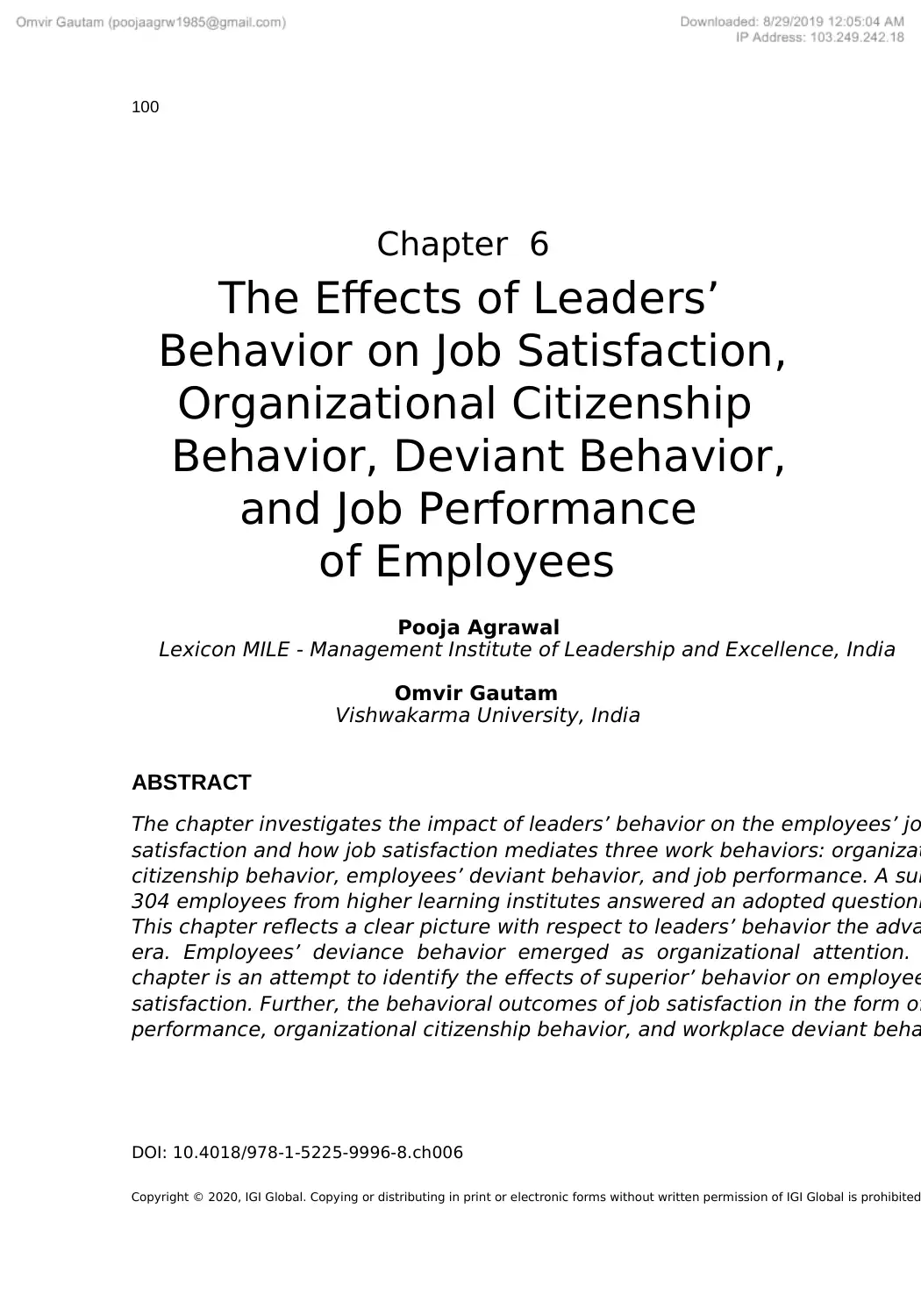
100
Copyright © 2020, IGI Global. Copying or distributing in print or electronic forms without written permission of IGI Global is prohibited
Chapter 6
DOI: 10.4018/978-1-5225-9996-8.ch006
ABSTRACT
The chapter investigates the impact of leaders’ behavior on the employees’ jo
satisfaction and how job satisfaction mediates three work behaviors: organizat
citizenship behavior, employees’ deviant behavior, and job performance. A sum
304 employees from higher learning institutes answered an adopted questionn
This chapter reflects a clear picture with respect to leaders’ behavior the adva
era. Employees’ deviance behavior emerged as organizational attention.
chapter is an attempt to identify the effects of superior’ behavior on employee
satisfaction. Further, the behavioral outcomes of job satisfaction in the form of
performance, organizational citizenship behavior, and workplace deviant beha
The Effects of Leaders’
Behavior on Job Satisfaction,
Organizational Citizenship
Behavior, Deviant Behavior,
and Job Performance
of Employees
Pooja Agrawal
Lexicon MILE - Management Institute of Leadership and Excellence, India
Omvir Gautam
Vishwakarma University, India
Copyright © 2020, IGI Global. Copying or distributing in print or electronic forms without written permission of IGI Global is prohibited
Chapter 6
DOI: 10.4018/978-1-5225-9996-8.ch006
ABSTRACT
The chapter investigates the impact of leaders’ behavior on the employees’ jo
satisfaction and how job satisfaction mediates three work behaviors: organizat
citizenship behavior, employees’ deviant behavior, and job performance. A sum
304 employees from higher learning institutes answered an adopted questionn
This chapter reflects a clear picture with respect to leaders’ behavior the adva
era. Employees’ deviance behavior emerged as organizational attention.
chapter is an attempt to identify the effects of superior’ behavior on employee
satisfaction. Further, the behavioral outcomes of job satisfaction in the form of
performance, organizational citizenship behavior, and workplace deviant beha
The Effects of Leaders’
Behavior on Job Satisfaction,
Organizational Citizenship
Behavior, Deviant Behavior,
and Job Performance
of Employees
Pooja Agrawal
Lexicon MILE - Management Institute of Leadership and Excellence, India
Omvir Gautam
Vishwakarma University, India
Secure Best Marks with AI Grader
Need help grading? Try our AI Grader for instant feedback on your assignments.
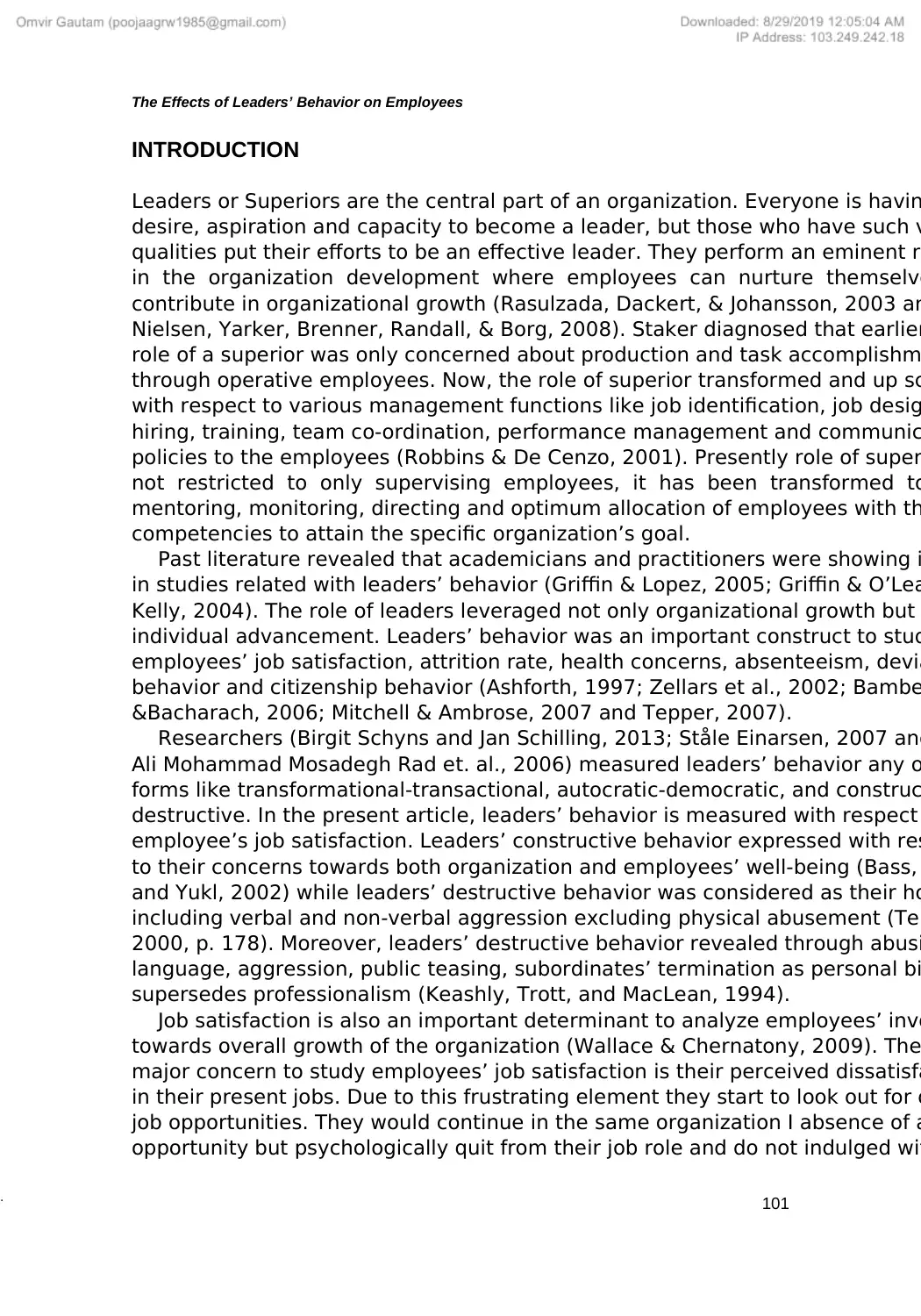
d. 101
The Effects of Leaders’ Behavior on Employees
INTRODUCTION
Leaders or Superiors are the central part of an organization. Everyone is havin
desire, aspiration and capacity to become a leader, but those who have such v
qualities put their efforts to be an effective leader. They perform an eminent ro
in the organization development where employees can nurture themselve
contribute in organizational growth (Rasulzada, Dackert, & Johansson, 2003 an
Nielsen, Yarker, Brenner, Randall, & Borg, 2008). Staker diagnosed that earlier
role of a superior was only concerned about production and task accomplishm
through operative employees. Now, the role of superior transformed and up sc
with respect to various management functions like job identification, job desig
hiring, training, team co-ordination, performance management and communic
policies to the employees (Robbins & De Cenzo, 2001). Presently role of super
not restricted to only supervising employees, it has been transformed to
mentoring, monitoring, directing and optimum allocation of employees with th
competencies to attain the specific organization’s goal.
Past literature revealed that academicians and practitioners were showing i
in studies related with leaders’ behavior (Griffin & Lopez, 2005; Griffin & O’Lea
Kelly, 2004). The role of leaders leveraged not only organizational growth but
individual advancement. Leaders’ behavior was an important construct to stud
employees’ job satisfaction, attrition rate, health concerns, absenteeism, devia
behavior and citizenship behavior (Ashforth, 1997; Zellars et al., 2002; Bambe
&Bacharach, 2006; Mitchell & Ambrose, 2007 and Tepper, 2007).
Researchers (Birgit Schyns and Jan Schilling, 2013; Ståle Einarsen, 2007 and
Ali Mohammad Mosadegh Rad et. al., 2006) measured leaders’ behavior any o
forms like transformational-transactional, autocratic-democratic, and construc
destructive. In the present article, leaders’ behavior is measured with respect
employee’s job satisfaction. Leaders’ constructive behavior expressed with res
to their concerns towards both organization and employees’ well-being (Bass,
and Yukl, 2002) while leaders’ destructive behavior was considered as their ho
including verbal and non-verbal aggression excluding physical abusement (Tep
2000, p. 178). Moreover, leaders’ destructive behavior revealed through abusi
language, aggression, public teasing, subordinates’ termination as personal bi
supersedes professionalism (Keashly, Trott, and MacLean, 1994).
Job satisfaction is also an important determinant to analyze employees’ invo
towards overall growth of the organization (Wallace & Chernatony, 2009). The
major concern to study employees’ job satisfaction is their perceived dissatisfa
in their present jobs. Due to this frustrating element they start to look out for o
job opportunities. They would continue in the same organization I absence of a
opportunity but psychologically quit from their job role and do not indulged wit
The Effects of Leaders’ Behavior on Employees
INTRODUCTION
Leaders or Superiors are the central part of an organization. Everyone is havin
desire, aspiration and capacity to become a leader, but those who have such v
qualities put their efforts to be an effective leader. They perform an eminent ro
in the organization development where employees can nurture themselve
contribute in organizational growth (Rasulzada, Dackert, & Johansson, 2003 an
Nielsen, Yarker, Brenner, Randall, & Borg, 2008). Staker diagnosed that earlier
role of a superior was only concerned about production and task accomplishm
through operative employees. Now, the role of superior transformed and up sc
with respect to various management functions like job identification, job desig
hiring, training, team co-ordination, performance management and communic
policies to the employees (Robbins & De Cenzo, 2001). Presently role of super
not restricted to only supervising employees, it has been transformed to
mentoring, monitoring, directing and optimum allocation of employees with th
competencies to attain the specific organization’s goal.
Past literature revealed that academicians and practitioners were showing i
in studies related with leaders’ behavior (Griffin & Lopez, 2005; Griffin & O’Lea
Kelly, 2004). The role of leaders leveraged not only organizational growth but
individual advancement. Leaders’ behavior was an important construct to stud
employees’ job satisfaction, attrition rate, health concerns, absenteeism, devia
behavior and citizenship behavior (Ashforth, 1997; Zellars et al., 2002; Bambe
&Bacharach, 2006; Mitchell & Ambrose, 2007 and Tepper, 2007).
Researchers (Birgit Schyns and Jan Schilling, 2013; Ståle Einarsen, 2007 and
Ali Mohammad Mosadegh Rad et. al., 2006) measured leaders’ behavior any o
forms like transformational-transactional, autocratic-democratic, and construc
destructive. In the present article, leaders’ behavior is measured with respect
employee’s job satisfaction. Leaders’ constructive behavior expressed with res
to their concerns towards both organization and employees’ well-being (Bass,
and Yukl, 2002) while leaders’ destructive behavior was considered as their ho
including verbal and non-verbal aggression excluding physical abusement (Tep
2000, p. 178). Moreover, leaders’ destructive behavior revealed through abusi
language, aggression, public teasing, subordinates’ termination as personal bi
supersedes professionalism (Keashly, Trott, and MacLean, 1994).
Job satisfaction is also an important determinant to analyze employees’ invo
towards overall growth of the organization (Wallace & Chernatony, 2009). The
major concern to study employees’ job satisfaction is their perceived dissatisfa
in their present jobs. Due to this frustrating element they start to look out for o
job opportunities. They would continue in the same organization I absence of a
opportunity but psychologically quit from their job role and do not indulged wit
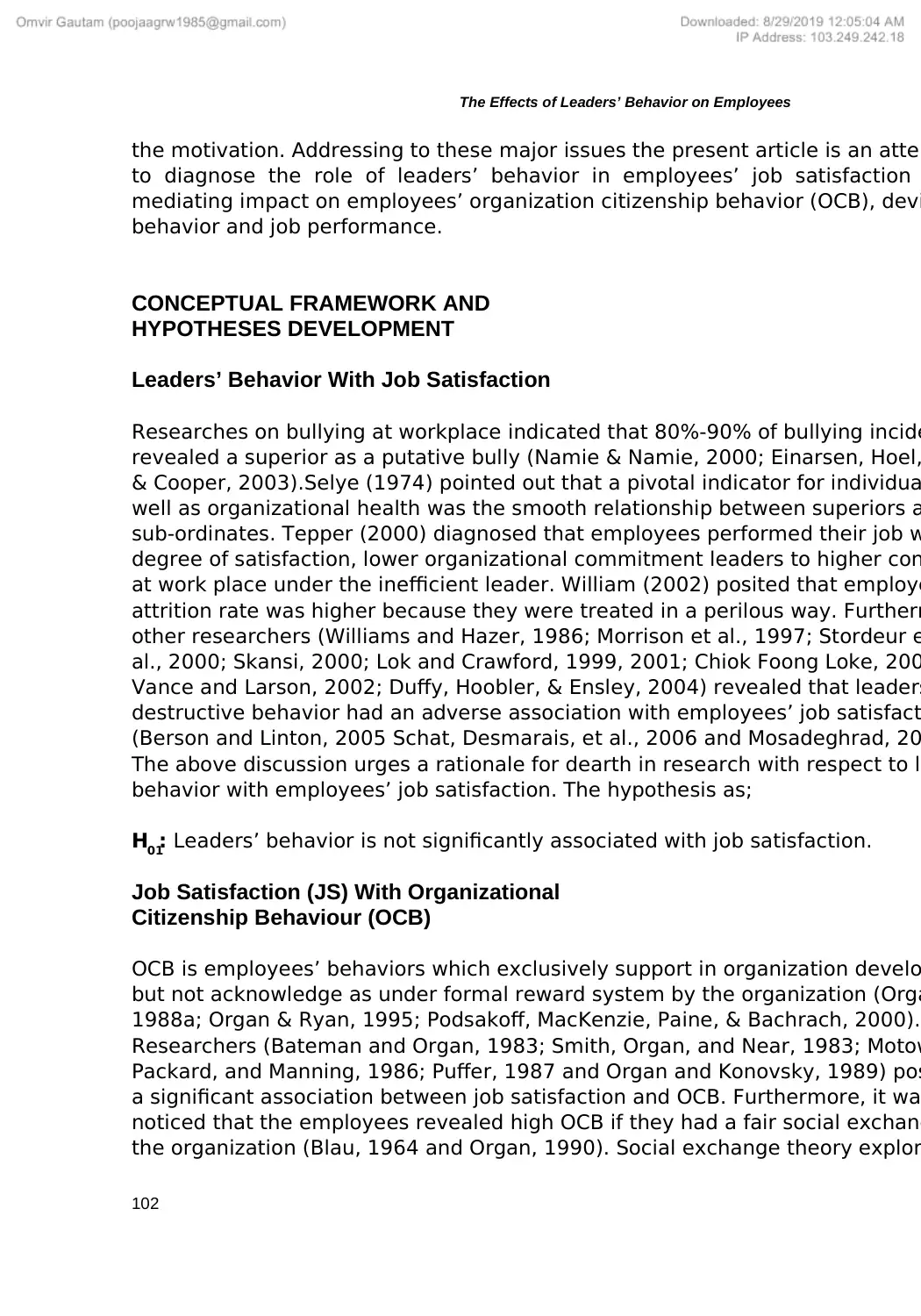
102
The Effects of Leaders’ Behavior on Employees
the motivation. Addressing to these major issues the present article is an attem
to diagnose the role of leaders’ behavior in employees’ job satisfaction
mediating impact on employees’ organization citizenship behavior (OCB), devi
behavior and job performance.
CONCEPTUAL FRAMEWORK AND
HYPOTHESES DEVELOPMENT
Leaders’ Behavior With Job Satisfaction
Researches on bullying at workplace indicated that 80%-90% of bullying incide
revealed a superior as a putative bully (Namie & Namie, 2000; Einarsen, Hoel,
& Cooper, 2003).Selye (1974) pointed out that a pivotal indicator for individua
well as organizational health was the smooth relationship between superiors a
sub-ordinates. Tepper (2000) diagnosed that employees performed their job w
degree of satisfaction, lower organizational commitment leaders to higher con
at work place under the inefficient leader. William (2002) posited that employe
attrition rate was higher because they were treated in a perilous way. Furtherm
other researchers (Williams and Hazer, 1986; Morrison et al., 1997; Stordeur e
al., 2000; Skansi, 2000; Lok and Crawford, 1999, 2001; Chiok Foong Loke, 200
Vance and Larson, 2002; Duffy, Hoobler, & Ensley, 2004) revealed that leaders
destructive behavior had an adverse association with employees’ job satisfact
(Berson and Linton, 2005 Schat, Desmarais, et al., 2006 and Mosadeghrad, 20
The above discussion urges a rationale for dearth in research with respect to le
behavior with employees’ job satisfaction. The hypothesis as;
H01
: Leaders’ behavior is not significantly associated with job satisfaction.
Job Satisfaction (JS) With Organizational
Citizenship Behaviour (OCB)
OCB is employees’ behaviors which exclusively support in organization develo
but not acknowledge as under formal reward system by the organization (Orga
1988a; Organ & Ryan, 1995; Podsakoff, MacKenzie, Paine, & Bachrach, 2000).
Researchers (Bateman and Organ, 1983; Smith, Organ, and Near, 1983; Motow
Packard, and Manning, 1986; Puffer, 1987 and Organ and Konovsky, 1989) pos
a significant association between job satisfaction and OCB. Furthermore, it wa
noticed that the employees revealed high OCB if they had a fair social exchang
the organization (Blau, 1964 and Organ, 1990). Social exchange theory explor
The Effects of Leaders’ Behavior on Employees
the motivation. Addressing to these major issues the present article is an attem
to diagnose the role of leaders’ behavior in employees’ job satisfaction
mediating impact on employees’ organization citizenship behavior (OCB), devi
behavior and job performance.
CONCEPTUAL FRAMEWORK AND
HYPOTHESES DEVELOPMENT
Leaders’ Behavior With Job Satisfaction
Researches on bullying at workplace indicated that 80%-90% of bullying incide
revealed a superior as a putative bully (Namie & Namie, 2000; Einarsen, Hoel,
& Cooper, 2003).Selye (1974) pointed out that a pivotal indicator for individua
well as organizational health was the smooth relationship between superiors a
sub-ordinates. Tepper (2000) diagnosed that employees performed their job w
degree of satisfaction, lower organizational commitment leaders to higher con
at work place under the inefficient leader. William (2002) posited that employe
attrition rate was higher because they were treated in a perilous way. Furtherm
other researchers (Williams and Hazer, 1986; Morrison et al., 1997; Stordeur e
al., 2000; Skansi, 2000; Lok and Crawford, 1999, 2001; Chiok Foong Loke, 200
Vance and Larson, 2002; Duffy, Hoobler, & Ensley, 2004) revealed that leaders
destructive behavior had an adverse association with employees’ job satisfact
(Berson and Linton, 2005 Schat, Desmarais, et al., 2006 and Mosadeghrad, 20
The above discussion urges a rationale for dearth in research with respect to le
behavior with employees’ job satisfaction. The hypothesis as;
H01
: Leaders’ behavior is not significantly associated with job satisfaction.
Job Satisfaction (JS) With Organizational
Citizenship Behaviour (OCB)
OCB is employees’ behaviors which exclusively support in organization develo
but not acknowledge as under formal reward system by the organization (Orga
1988a; Organ & Ryan, 1995; Podsakoff, MacKenzie, Paine, & Bachrach, 2000).
Researchers (Bateman and Organ, 1983; Smith, Organ, and Near, 1983; Motow
Packard, and Manning, 1986; Puffer, 1987 and Organ and Konovsky, 1989) pos
a significant association between job satisfaction and OCB. Furthermore, it wa
noticed that the employees revealed high OCB if they had a fair social exchang
the organization (Blau, 1964 and Organ, 1990). Social exchange theory explor
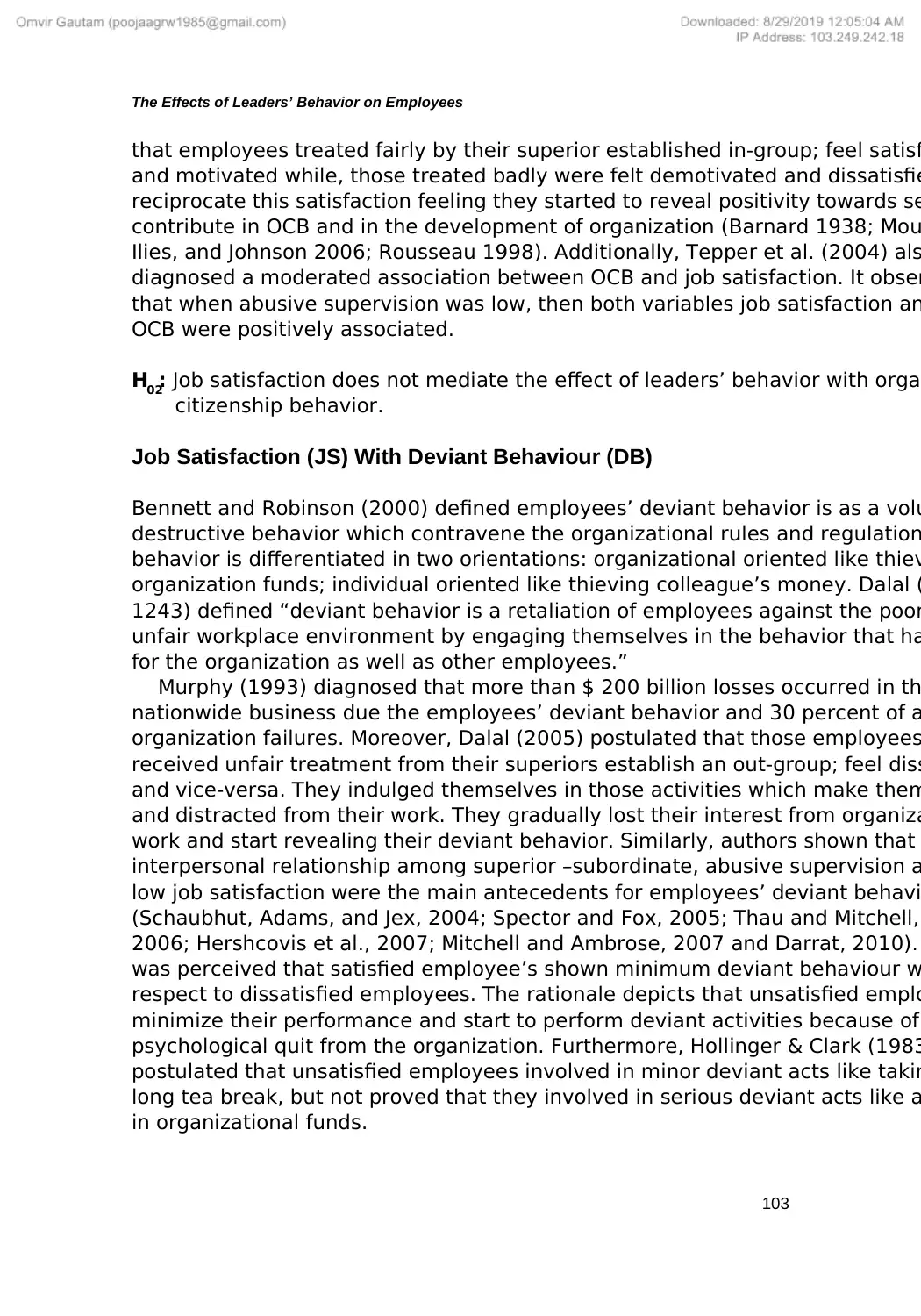
103
The Effects of Leaders’ Behavior on Employees
that employees treated fairly by their superior established in-group; feel satisfi
and motivated while, those treated badly were felt demotivated and dissatisfie
reciprocate this satisfaction feeling they started to reveal positivity towards se
contribute in OCB and in the development of organization (Barnard 1938; Mou
Ilies, and Johnson 2006; Rousseau 1998). Additionally, Tepper et al. (2004) als
diagnosed a moderated association between OCB and job satisfaction. It obser
that when abusive supervision was low, then both variables job satisfaction an
OCB were positively associated.
H02
: Job satisfaction does not mediate the effect of leaders’ behavior with organ
citizenship behavior.
Job Satisfaction (JS) With Deviant Behaviour (DB)
Bennett and Robinson (2000) defined employees’ deviant behavior is as a volu
destructive behavior which contravene the organizational rules and regulation
behavior is differentiated in two orientations: organizational oriented like thiev
organization funds; individual oriented like thieving colleague’s money. Dalal (
1243) defined “deviant behavior is a retaliation of employees against the poor
unfair workplace environment by engaging themselves in the behavior that ha
for the organization as well as other employees.”
Murphy (1993) diagnosed that more than $ 200 billion losses occurred in th
nationwide business due the employees’ deviant behavior and 30 percent of a
organization failures. Moreover, Dalal (2005) postulated that those employees
received unfair treatment from their superiors establish an out-group; feel diss
and vice-versa. They indulged themselves in those activities which make them
and distracted from their work. They gradually lost their interest from organiza
work and start revealing their deviant behavior. Similarly, authors shown that
interpersonal relationship among superior –subordinate, abusive supervision a
low job satisfaction were the main antecedents for employees’ deviant behavi
(Schaubhut, Adams, and Jex, 2004; Spector and Fox, 2005; Thau and Mitchell,
2006; Hershcovis et al., 2007; Mitchell and Ambrose, 2007 and Darrat, 2010).
was perceived that satisfied employee’s shown minimum deviant behaviour w
respect to dissatisfied employees. The rationale depicts that unsatisfied emplo
minimize their performance and start to perform deviant activities because of
psychological quit from the organization. Furthermore, Hollinger & Clark (1983
postulated that unsatisfied employees involved in minor deviant acts like takin
long tea break, but not proved that they involved in serious deviant acts like a
in organizational funds.
The Effects of Leaders’ Behavior on Employees
that employees treated fairly by their superior established in-group; feel satisfi
and motivated while, those treated badly were felt demotivated and dissatisfie
reciprocate this satisfaction feeling they started to reveal positivity towards se
contribute in OCB and in the development of organization (Barnard 1938; Mou
Ilies, and Johnson 2006; Rousseau 1998). Additionally, Tepper et al. (2004) als
diagnosed a moderated association between OCB and job satisfaction. It obser
that when abusive supervision was low, then both variables job satisfaction an
OCB were positively associated.
H02
: Job satisfaction does not mediate the effect of leaders’ behavior with organ
citizenship behavior.
Job Satisfaction (JS) With Deviant Behaviour (DB)
Bennett and Robinson (2000) defined employees’ deviant behavior is as a volu
destructive behavior which contravene the organizational rules and regulation
behavior is differentiated in two orientations: organizational oriented like thiev
organization funds; individual oriented like thieving colleague’s money. Dalal (
1243) defined “deviant behavior is a retaliation of employees against the poor
unfair workplace environment by engaging themselves in the behavior that ha
for the organization as well as other employees.”
Murphy (1993) diagnosed that more than $ 200 billion losses occurred in th
nationwide business due the employees’ deviant behavior and 30 percent of a
organization failures. Moreover, Dalal (2005) postulated that those employees
received unfair treatment from their superiors establish an out-group; feel diss
and vice-versa. They indulged themselves in those activities which make them
and distracted from their work. They gradually lost their interest from organiza
work and start revealing their deviant behavior. Similarly, authors shown that
interpersonal relationship among superior –subordinate, abusive supervision a
low job satisfaction were the main antecedents for employees’ deviant behavi
(Schaubhut, Adams, and Jex, 2004; Spector and Fox, 2005; Thau and Mitchell,
2006; Hershcovis et al., 2007; Mitchell and Ambrose, 2007 and Darrat, 2010).
was perceived that satisfied employee’s shown minimum deviant behaviour w
respect to dissatisfied employees. The rationale depicts that unsatisfied emplo
minimize their performance and start to perform deviant activities because of
psychological quit from the organization. Furthermore, Hollinger & Clark (1983
postulated that unsatisfied employees involved in minor deviant acts like takin
long tea break, but not proved that they involved in serious deviant acts like a
in organizational funds.
Secure Best Marks with AI Grader
Need help grading? Try our AI Grader for instant feedback on your assignments.
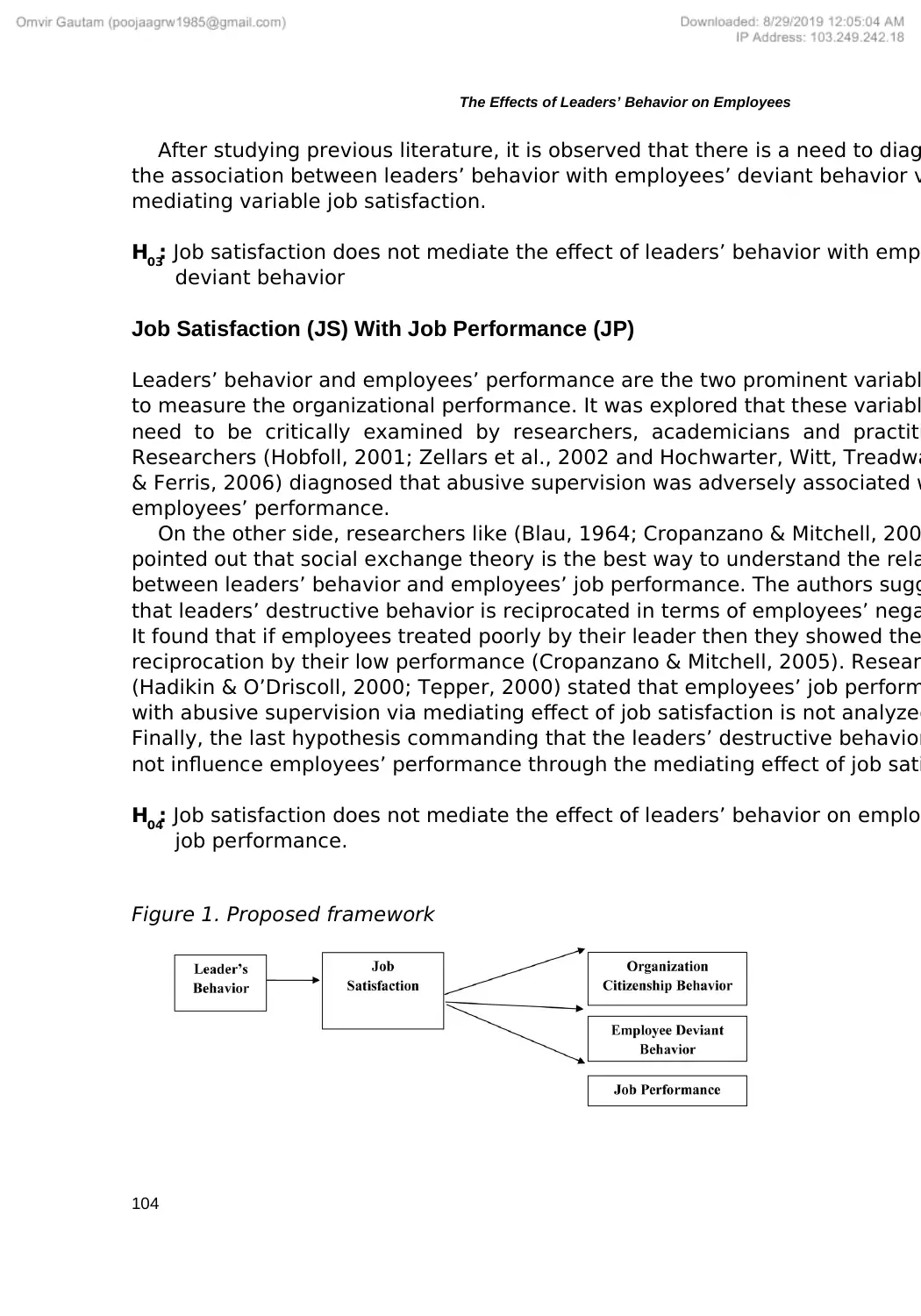
104
The Effects of Leaders’ Behavior on Employees
After studying previous literature, it is observed that there is a need to diag
the association between leaders’ behavior with employees’ deviant behavior v
mediating variable job satisfaction.
H03
: Job satisfaction does not mediate the effect of leaders’ behavior with empl
deviant behavior
Job Satisfaction (JS) With Job Performance (JP)
Leaders’ behavior and employees’ performance are the two prominent variabl
to measure the organizational performance. It was explored that these variabl
need to be critically examined by researchers, academicians and practiti
Researchers (Hobfoll, 2001; Zellars et al., 2002 and Hochwarter, Witt, Treadwa
& Ferris, 2006) diagnosed that abusive supervision was adversely associated w
employees’ performance.
On the other side, researchers like (Blau, 1964; Cropanzano & Mitchell, 200
pointed out that social exchange theory is the best way to understand the rela
between leaders’ behavior and employees’ job performance. The authors sugg
that leaders’ destructive behavior is reciprocated in terms of employees’ nega
It found that if employees treated poorly by their leader then they showed the
reciprocation by their low performance (Cropanzano & Mitchell, 2005). Resear
(Hadikin & O’Driscoll, 2000; Tepper, 2000) stated that employees’ job perform
with abusive supervision via mediating effect of job satisfaction is not analyzed
Finally, the last hypothesis commanding that the leaders’ destructive behavior
not influence employees’ performance through the mediating effect of job sati
H04
: Job satisfaction does not mediate the effect of leaders’ behavior on employ
job performance.
Figure 1. Proposed framework
The Effects of Leaders’ Behavior on Employees
After studying previous literature, it is observed that there is a need to diag
the association between leaders’ behavior with employees’ deviant behavior v
mediating variable job satisfaction.
H03
: Job satisfaction does not mediate the effect of leaders’ behavior with empl
deviant behavior
Job Satisfaction (JS) With Job Performance (JP)
Leaders’ behavior and employees’ performance are the two prominent variabl
to measure the organizational performance. It was explored that these variabl
need to be critically examined by researchers, academicians and practiti
Researchers (Hobfoll, 2001; Zellars et al., 2002 and Hochwarter, Witt, Treadwa
& Ferris, 2006) diagnosed that abusive supervision was adversely associated w
employees’ performance.
On the other side, researchers like (Blau, 1964; Cropanzano & Mitchell, 200
pointed out that social exchange theory is the best way to understand the rela
between leaders’ behavior and employees’ job performance. The authors sugg
that leaders’ destructive behavior is reciprocated in terms of employees’ nega
It found that if employees treated poorly by their leader then they showed the
reciprocation by their low performance (Cropanzano & Mitchell, 2005). Resear
(Hadikin & O’Driscoll, 2000; Tepper, 2000) stated that employees’ job perform
with abusive supervision via mediating effect of job satisfaction is not analyzed
Finally, the last hypothesis commanding that the leaders’ destructive behavior
not influence employees’ performance through the mediating effect of job sati
H04
: Job satisfaction does not mediate the effect of leaders’ behavior on employ
job performance.
Figure 1. Proposed framework
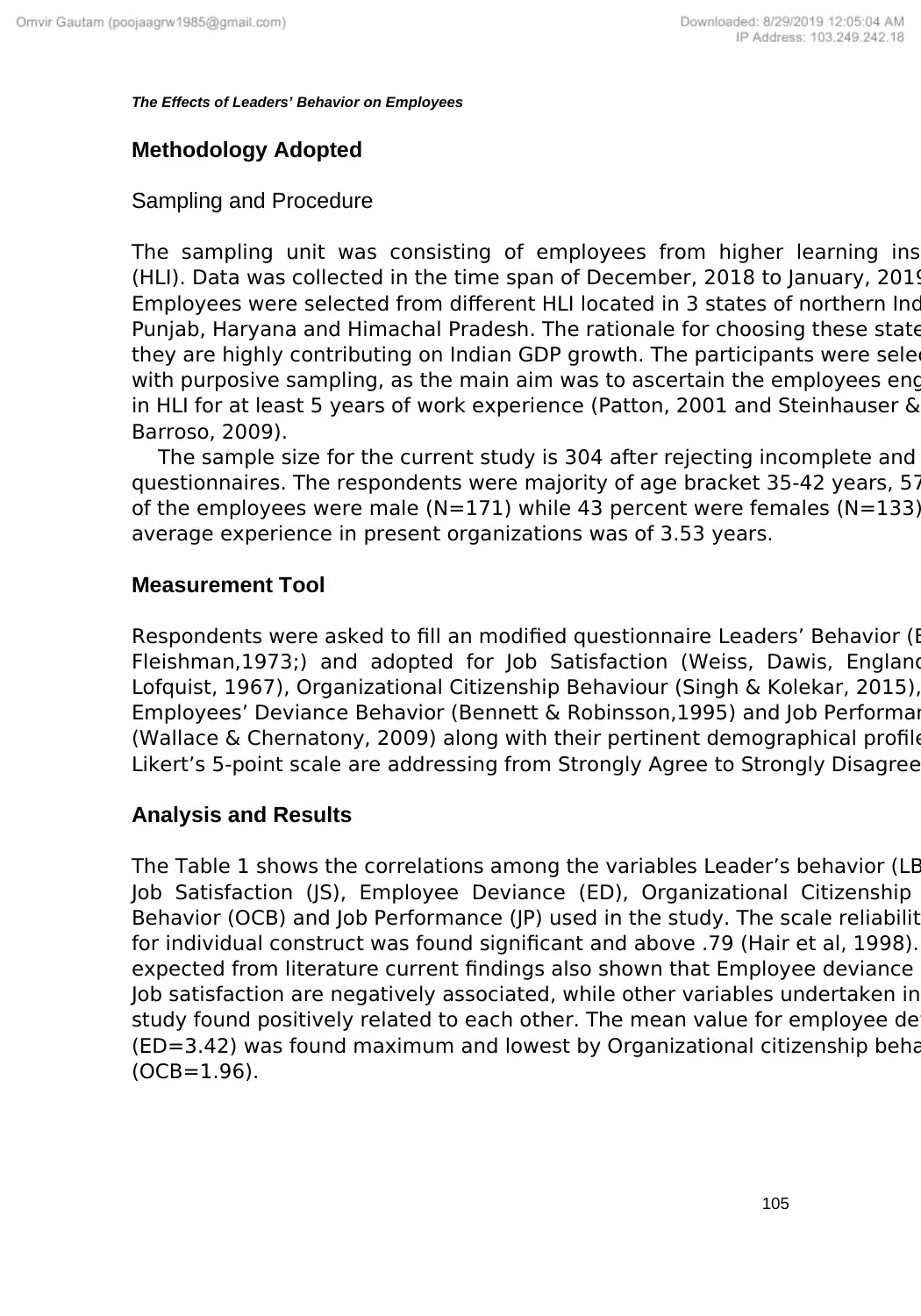
105
The Effects of Leaders’ Behavior on Employees
Methodology Adopted
Sampling and Procedure
The sampling unit was consisting of employees from higher learning inst
(HLI). Data was collected in the time span of December, 2018 to January, 2019
Employees were selected from different HLI located in 3 states of northern Ind
Punjab, Haryana and Himachal Pradesh. The rationale for choosing these state
they are highly contributing on Indian GDP growth. The participants were selec
with purposive sampling, as the main aim was to ascertain the employees eng
in HLI for at least 5 years of work experience (Patton, 2001 and Steinhauser &
Barroso, 2009).
The sample size for the current study is 304 after rejecting incomplete and
questionnaires. The respondents were majority of age bracket 35-42 years, 57
of the employees were male (N=171) while 43 percent were females (N=133)
average experience in present organizations was of 3.53 years.
Measurement Tool
Respondents were asked to fill an modified questionnaire Leaders’ Behavior (E
Fleishman,1973;) and adopted for Job Satisfaction (Weiss, Dawis, England
Lofquist, 1967), Organizational Citizenship Behaviour (Singh & Kolekar, 2015),
Employees’ Deviance Behavior (Bennett & Robinsson,1995) and Job Performan
(Wallace & Chernatony, 2009) along with their pertinent demographical profile
Likert’s 5-point scale are addressing from Strongly Agree to Strongly Disagree
Analysis and Results
The Table 1 shows the correlations among the variables Leader’s behavior (LB
Job Satisfaction (JS), Employee Deviance (ED), Organizational Citizenship
Behavior (OCB) and Job Performance (JP) used in the study. The scale reliabiliti
for individual construct was found significant and above .79 (Hair et al, 1998).
expected from literature current findings also shown that Employee deviance a
Job satisfaction are negatively associated, while other variables undertaken in
study found positively related to each other. The mean value for employee dev
(ED=3.42) was found maximum and lowest by Organizational citizenship beha
(OCB=1.96).
The Effects of Leaders’ Behavior on Employees
Methodology Adopted
Sampling and Procedure
The sampling unit was consisting of employees from higher learning inst
(HLI). Data was collected in the time span of December, 2018 to January, 2019
Employees were selected from different HLI located in 3 states of northern Ind
Punjab, Haryana and Himachal Pradesh. The rationale for choosing these state
they are highly contributing on Indian GDP growth. The participants were selec
with purposive sampling, as the main aim was to ascertain the employees eng
in HLI for at least 5 years of work experience (Patton, 2001 and Steinhauser &
Barroso, 2009).
The sample size for the current study is 304 after rejecting incomplete and
questionnaires. The respondents were majority of age bracket 35-42 years, 57
of the employees were male (N=171) while 43 percent were females (N=133)
average experience in present organizations was of 3.53 years.
Measurement Tool
Respondents were asked to fill an modified questionnaire Leaders’ Behavior (E
Fleishman,1973;) and adopted for Job Satisfaction (Weiss, Dawis, England
Lofquist, 1967), Organizational Citizenship Behaviour (Singh & Kolekar, 2015),
Employees’ Deviance Behavior (Bennett & Robinsson,1995) and Job Performan
(Wallace & Chernatony, 2009) along with their pertinent demographical profile
Likert’s 5-point scale are addressing from Strongly Agree to Strongly Disagree
Analysis and Results
The Table 1 shows the correlations among the variables Leader’s behavior (LB
Job Satisfaction (JS), Employee Deviance (ED), Organizational Citizenship
Behavior (OCB) and Job Performance (JP) used in the study. The scale reliabiliti
for individual construct was found significant and above .79 (Hair et al, 1998).
expected from literature current findings also shown that Employee deviance a
Job satisfaction are negatively associated, while other variables undertaken in
study found positively related to each other. The mean value for employee dev
(ED=3.42) was found maximum and lowest by Organizational citizenship beha
(OCB=1.96).
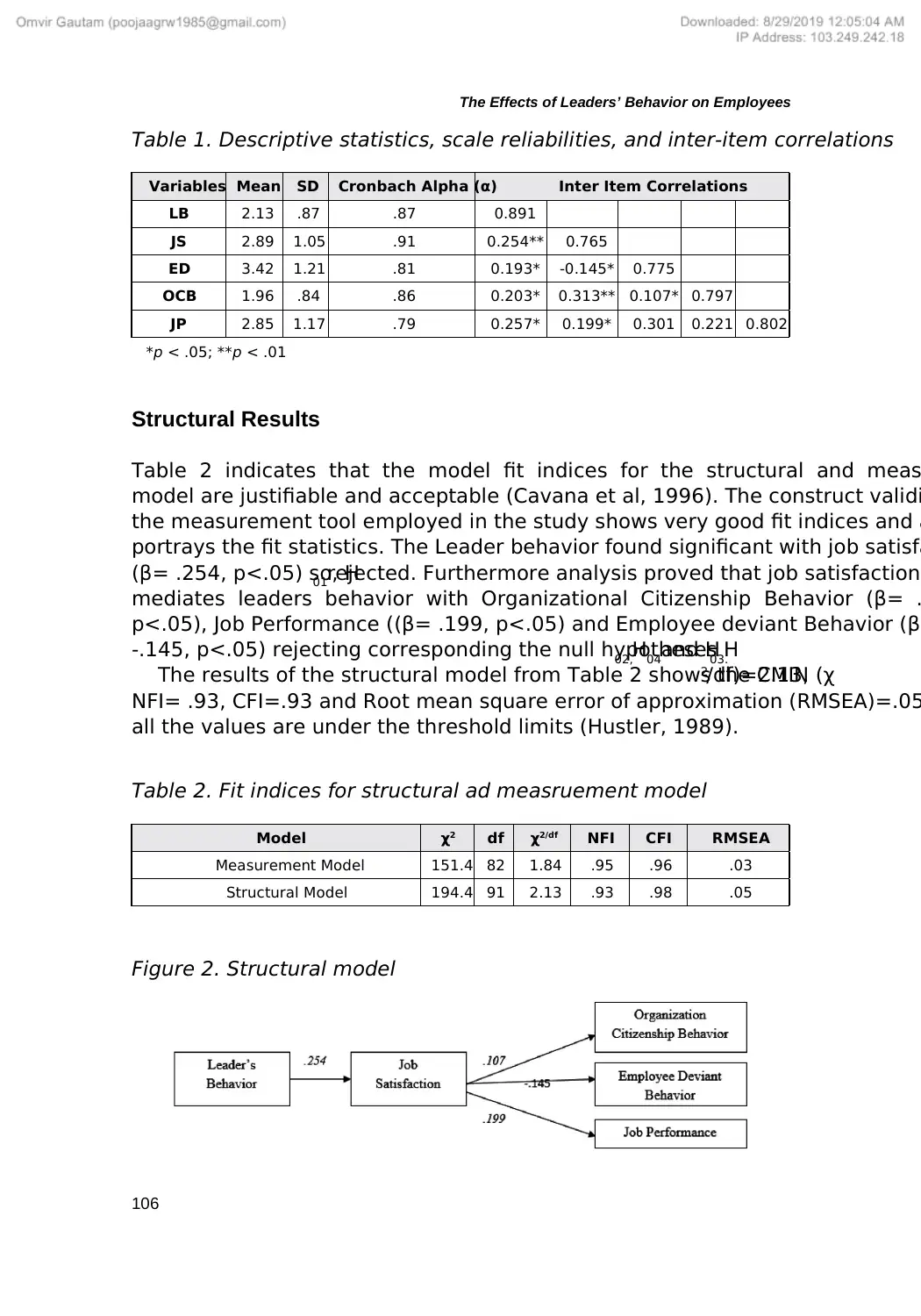
106
The Effects of Leaders’ Behavior on Employees
Structural Results
Table 2 indicates that the model fit indices for the structural and meas
model are justifiable and acceptable (Cavana et al, 1996). The construct validi
the measurement tool employed in the study shows very good fit indices and a
portrays the fit statistics. The Leader behavior found significant with job satisfa
(β= .254, p<.05) so, H01rejected. Furthermore analysis proved that job satisfaction
mediates leaders behavior with Organizational Citizenship Behavior (β= .
p<.05), Job Performance ((β= .199, p<.05) and Employee deviant Behavior (β=
-.145, p<.05) rejecting corresponding the null hypotheses H02,H04and H03.
The results of the structural model from Table 2 shows the CMIN (χ2/df)=2.13,
NFI= .93, CFI=.93 and Root mean square error of approximation (RMSEA)=.05
all the values are under the threshold limits (Hustler, 1989).
Table 1. Descriptive statistics, scale reliabilities, and inter-item correlations
Variables Mean SD Cronbach Alpha (α) Inter Item Correlations
LB 2.13 .87 .87 0.891
JS 2.89 1.05 .91 0.254** 0.765
ED 3.42 1.21 .81 0.193* -0.145* 0.775
OCB 1.96 .84 .86 0.203* 0.313** 0.107* 0.797
JP 2.85 1.17 .79 0.257* 0.199* 0.301 0.221 0.802
*p < .05; **p < .01
Table 2. Fit indices for structural ad measruement model
Model χ2 df χ2/df NFI CFI RMSEA
Measurement Model 151.4 82 1.84 .95 .96 .03
Structural Model 194.4 91 2.13 .93 .98 .05
Figure 2. Structural model
The Effects of Leaders’ Behavior on Employees
Structural Results
Table 2 indicates that the model fit indices for the structural and meas
model are justifiable and acceptable (Cavana et al, 1996). The construct validi
the measurement tool employed in the study shows very good fit indices and a
portrays the fit statistics. The Leader behavior found significant with job satisfa
(β= .254, p<.05) so, H01rejected. Furthermore analysis proved that job satisfaction
mediates leaders behavior with Organizational Citizenship Behavior (β= .
p<.05), Job Performance ((β= .199, p<.05) and Employee deviant Behavior (β=
-.145, p<.05) rejecting corresponding the null hypotheses H02,H04and H03.
The results of the structural model from Table 2 shows the CMIN (χ2/df)=2.13,
NFI= .93, CFI=.93 and Root mean square error of approximation (RMSEA)=.05
all the values are under the threshold limits (Hustler, 1989).
Table 1. Descriptive statistics, scale reliabilities, and inter-item correlations
Variables Mean SD Cronbach Alpha (α) Inter Item Correlations
LB 2.13 .87 .87 0.891
JS 2.89 1.05 .91 0.254** 0.765
ED 3.42 1.21 .81 0.193* -0.145* 0.775
OCB 1.96 .84 .86 0.203* 0.313** 0.107* 0.797
JP 2.85 1.17 .79 0.257* 0.199* 0.301 0.221 0.802
*p < .05; **p < .01
Table 2. Fit indices for structural ad measruement model
Model χ2 df χ2/df NFI CFI RMSEA
Measurement Model 151.4 82 1.84 .95 .96 .03
Structural Model 194.4 91 2.13 .93 .98 .05
Figure 2. Structural model
Paraphrase This Document
Need a fresh take? Get an instant paraphrase of this document with our AI Paraphraser
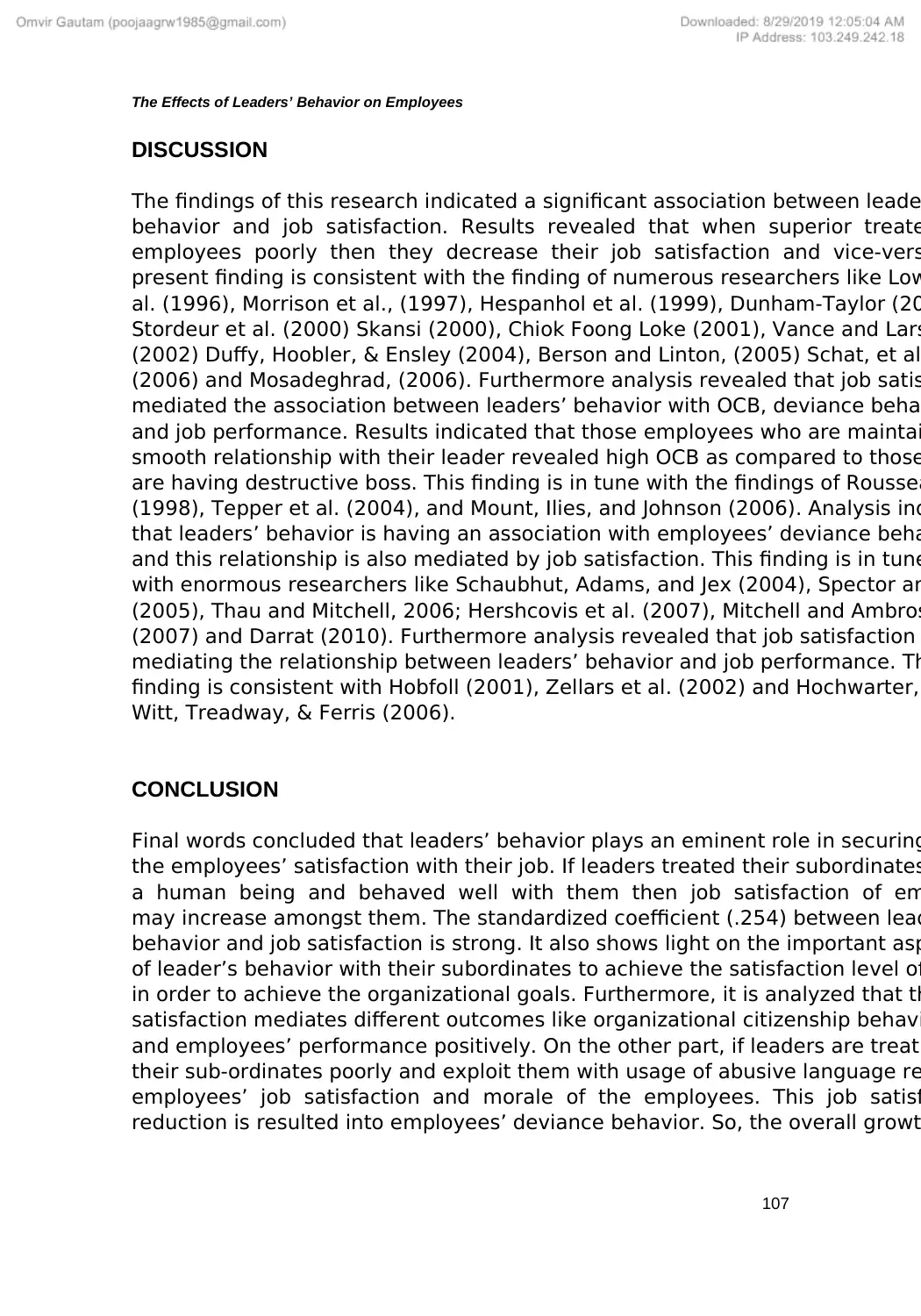
107
The Effects of Leaders’ Behavior on Employees
DISCUSSION
The findings of this research indicated a significant association between leade
behavior and job satisfaction. Results revealed that when superior treate
employees poorly then they decrease their job satisfaction and vice-vers
present finding is consistent with the finding of numerous researchers like Low
al. (1996), Morrison et al., (1997), Hespanhol et al. (1999), Dunham-Taylor (20
Stordeur et al. (2000) Skansi (2000), Chiok Foong Loke (2001), Vance and Lars
(2002) Duffy, Hoobler, & Ensley (2004), Berson and Linton, (2005) Schat, et al
(2006) and Mosadeghrad, (2006). Furthermore analysis revealed that job satis
mediated the association between leaders’ behavior with OCB, deviance behav
and job performance. Results indicated that those employees who are maintai
smooth relationship with their leader revealed high OCB as compared to those
are having destructive boss. This finding is in tune with the findings of Roussea
(1998), Tepper et al. (2004), and Mount, Ilies, and Johnson (2006). Analysis ind
that leaders’ behavior is having an association with employees’ deviance beha
and this relationship is also mediated by job satisfaction. This finding is in tune
with enormous researchers like Schaubhut, Adams, and Jex (2004), Spector an
(2005), Thau and Mitchell, 2006; Hershcovis et al. (2007), Mitchell and Ambros
(2007) and Darrat (2010). Furthermore analysis revealed that job satisfaction
mediating the relationship between leaders’ behavior and job performance. Th
finding is consistent with Hobfoll (2001), Zellars et al. (2002) and Hochwarter,
Witt, Treadway, & Ferris (2006).
CONCLUSION
Final words concluded that leaders’ behavior plays an eminent role in securing
the employees’ satisfaction with their job. If leaders treated their subordinates
a human being and behaved well with them then job satisfaction of em
may increase amongst them. The standardized coefficient (.254) between lead
behavior and job satisfaction is strong. It also shows light on the important asp
of leader’s behavior with their subordinates to achieve the satisfaction level of
in order to achieve the organizational goals. Furthermore, it is analyzed that th
satisfaction mediates different outcomes like organizational citizenship behavi
and employees’ performance positively. On the other part, if leaders are treati
their sub-ordinates poorly and exploit them with usage of abusive language re
employees’ job satisfaction and morale of the employees. This job satisf
reduction is resulted into employees’ deviance behavior. So, the overall growt
The Effects of Leaders’ Behavior on Employees
DISCUSSION
The findings of this research indicated a significant association between leade
behavior and job satisfaction. Results revealed that when superior treate
employees poorly then they decrease their job satisfaction and vice-vers
present finding is consistent with the finding of numerous researchers like Low
al. (1996), Morrison et al., (1997), Hespanhol et al. (1999), Dunham-Taylor (20
Stordeur et al. (2000) Skansi (2000), Chiok Foong Loke (2001), Vance and Lars
(2002) Duffy, Hoobler, & Ensley (2004), Berson and Linton, (2005) Schat, et al
(2006) and Mosadeghrad, (2006). Furthermore analysis revealed that job satis
mediated the association between leaders’ behavior with OCB, deviance behav
and job performance. Results indicated that those employees who are maintai
smooth relationship with their leader revealed high OCB as compared to those
are having destructive boss. This finding is in tune with the findings of Roussea
(1998), Tepper et al. (2004), and Mount, Ilies, and Johnson (2006). Analysis ind
that leaders’ behavior is having an association with employees’ deviance beha
and this relationship is also mediated by job satisfaction. This finding is in tune
with enormous researchers like Schaubhut, Adams, and Jex (2004), Spector an
(2005), Thau and Mitchell, 2006; Hershcovis et al. (2007), Mitchell and Ambros
(2007) and Darrat (2010). Furthermore analysis revealed that job satisfaction
mediating the relationship between leaders’ behavior and job performance. Th
finding is consistent with Hobfoll (2001), Zellars et al. (2002) and Hochwarter,
Witt, Treadway, & Ferris (2006).
CONCLUSION
Final words concluded that leaders’ behavior plays an eminent role in securing
the employees’ satisfaction with their job. If leaders treated their subordinates
a human being and behaved well with them then job satisfaction of em
may increase amongst them. The standardized coefficient (.254) between lead
behavior and job satisfaction is strong. It also shows light on the important asp
of leader’s behavior with their subordinates to achieve the satisfaction level of
in order to achieve the organizational goals. Furthermore, it is analyzed that th
satisfaction mediates different outcomes like organizational citizenship behavi
and employees’ performance positively. On the other part, if leaders are treati
their sub-ordinates poorly and exploit them with usage of abusive language re
employees’ job satisfaction and morale of the employees. This job satisf
reduction is resulted into employees’ deviance behavior. So, the overall growt
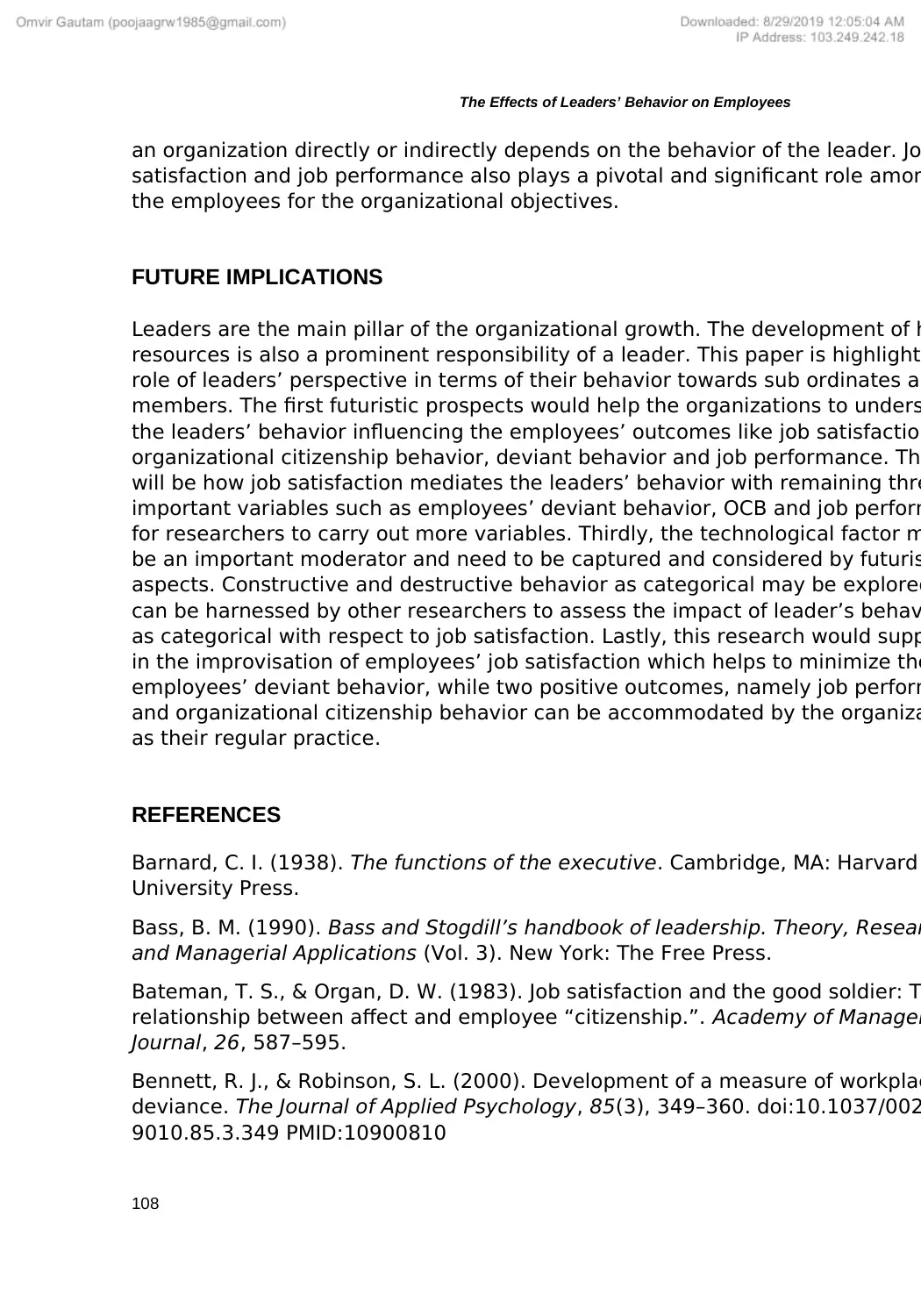
108
The Effects of Leaders’ Behavior on Employees
an organization directly or indirectly depends on the behavior of the leader. Jo
satisfaction and job performance also plays a pivotal and significant role amon
the employees for the organizational objectives.
FUTURE IMPLICATIONS
Leaders are the main pillar of the organizational growth. The development of h
resources is also a prominent responsibility of a leader. This paper is highlights
role of leaders’ perspective in terms of their behavior towards sub ordinates an
members. The first futuristic prospects would help the organizations to unders
the leaders’ behavior influencing the employees’ outcomes like job satisfaction
organizational citizenship behavior, deviant behavior and job performance. The
will be how job satisfaction mediates the leaders’ behavior with remaining thre
important variables such as employees’ deviant behavior, OCB and job perform
for researchers to carry out more variables. Thirdly, the technological factor m
be an important moderator and need to be captured and considered by futuris
aspects. Constructive and destructive behavior as categorical may be explored
can be harnessed by other researchers to assess the impact of leader’s behav
as categorical with respect to job satisfaction. Lastly, this research would supp
in the improvisation of employees’ job satisfaction which helps to minimize the
employees’ deviant behavior, while two positive outcomes, namely job perform
and organizational citizenship behavior can be accommodated by the organiza
as their regular practice.
REFERENCES
Barnard, C. I. (1938). The functions of the executive. Cambridge, MA: Harvard
University Press.
Bass, B. M. (1990). Bass and Stogdill’s handbook of leadership. Theory, Resear
and Managerial Applications (Vol. 3). New York: The Free Press.
Bateman, T. S., & Organ, D. W. (1983). Job satisfaction and the good soldier: T
relationship between affect and employee “citizenship.”. Academy of Managem
Journal, 26, 587–595.
Bennett, R. J., & Robinson, S. L. (2000). Development of a measure of workplac
deviance. The Journal of Applied Psychology, 85(3), 349–360. doi:10.1037/002
9010.85.3.349 PMID:10900810
The Effects of Leaders’ Behavior on Employees
an organization directly or indirectly depends on the behavior of the leader. Jo
satisfaction and job performance also plays a pivotal and significant role amon
the employees for the organizational objectives.
FUTURE IMPLICATIONS
Leaders are the main pillar of the organizational growth. The development of h
resources is also a prominent responsibility of a leader. This paper is highlights
role of leaders’ perspective in terms of their behavior towards sub ordinates an
members. The first futuristic prospects would help the organizations to unders
the leaders’ behavior influencing the employees’ outcomes like job satisfaction
organizational citizenship behavior, deviant behavior and job performance. The
will be how job satisfaction mediates the leaders’ behavior with remaining thre
important variables such as employees’ deviant behavior, OCB and job perform
for researchers to carry out more variables. Thirdly, the technological factor m
be an important moderator and need to be captured and considered by futuris
aspects. Constructive and destructive behavior as categorical may be explored
can be harnessed by other researchers to assess the impact of leader’s behav
as categorical with respect to job satisfaction. Lastly, this research would supp
in the improvisation of employees’ job satisfaction which helps to minimize the
employees’ deviant behavior, while two positive outcomes, namely job perform
and organizational citizenship behavior can be accommodated by the organiza
as their regular practice.
REFERENCES
Barnard, C. I. (1938). The functions of the executive. Cambridge, MA: Harvard
University Press.
Bass, B. M. (1990). Bass and Stogdill’s handbook of leadership. Theory, Resear
and Managerial Applications (Vol. 3). New York: The Free Press.
Bateman, T. S., & Organ, D. W. (1983). Job satisfaction and the good soldier: T
relationship between affect and employee “citizenship.”. Academy of Managem
Journal, 26, 587–595.
Bennett, R. J., & Robinson, S. L. (2000). Development of a measure of workplac
deviance. The Journal of Applied Psychology, 85(3), 349–360. doi:10.1037/002
9010.85.3.349 PMID:10900810
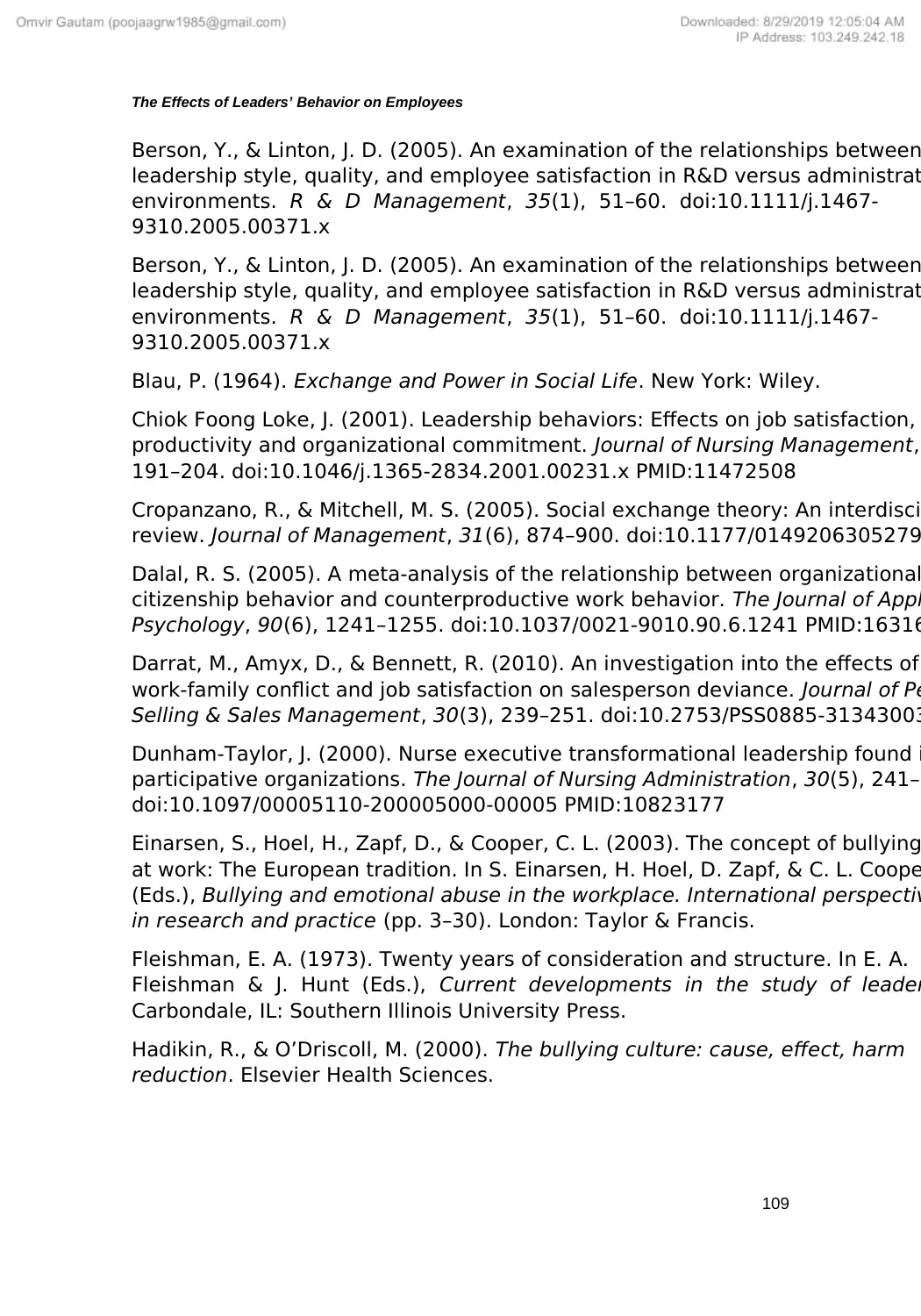
109
The Effects of Leaders’ Behavior on Employees
Berson, Y., & Linton, J. D. (2005). An examination of the relationships between
leadership style, quality, and employee satisfaction in R&D versus administrat
environments. R & D Management, 35(1), 51–60. doi:10.1111/j.1467-
9310.2005.00371.x
Berson, Y., & Linton, J. D. (2005). An examination of the relationships between
leadership style, quality, and employee satisfaction in R&D versus administrat
environments. R & D Management, 35(1), 51–60. doi:10.1111/j.1467-
9310.2005.00371.x
Blau, P. (1964). Exchange and Power in Social Life. New York: Wiley.
Chiok Foong Loke, J. (2001). Leadership behaviors: Effects on job satisfaction,
productivity and organizational commitment. Journal of Nursing Management,
191–204. doi:10.1046/j.1365-2834.2001.00231.x PMID:11472508
Cropanzano, R., & Mitchell, M. S. (2005). Social exchange theory: An interdisci
review. Journal of Management, 31(6), 874–900. doi:10.1177/0149206305279
Dalal, R. S. (2005). A meta-analysis of the relationship between organizational
citizenship behavior and counterproductive work behavior. The Journal of Appl
Psychology, 90(6), 1241–1255. doi:10.1037/0021-9010.90.6.1241 PMID:16316
Darrat, M., Amyx, D., & Bennett, R. (2010). An investigation into the effects of
work-family conflict and job satisfaction on salesperson deviance. Journal of Pe
Selling & Sales Management, 30(3), 239–251. doi:10.2753/PSS0885-31343003
Dunham-Taylor, J. (2000). Nurse executive transformational leadership found i
participative organizations. The Journal of Nursing Administration, 30(5), 241–2
doi:10.1097/00005110-200005000-00005 PMID:10823177
Einarsen, S., Hoel, H., Zapf, D., & Cooper, C. L. (2003). The concept of bullying
at work: The European tradition. In S. Einarsen, H. Hoel, D. Zapf, & C. L. Coope
(Eds.), Bullying and emotional abuse in the workplace. International perspectiv
in research and practice (pp. 3–30). London: Taylor & Francis.
Fleishman, E. A. (1973). Twenty years of consideration and structure. In E. A.
Fleishman & J. Hunt (Eds.), Current developments in the study of leader
Carbondale, IL: Southern Illinois University Press.
Hadikin, R., & O’Driscoll, M. (2000). The bullying culture: cause, effect, harm
reduction. Elsevier Health Sciences.
The Effects of Leaders’ Behavior on Employees
Berson, Y., & Linton, J. D. (2005). An examination of the relationships between
leadership style, quality, and employee satisfaction in R&D versus administrat
environments. R & D Management, 35(1), 51–60. doi:10.1111/j.1467-
9310.2005.00371.x
Berson, Y., & Linton, J. D. (2005). An examination of the relationships between
leadership style, quality, and employee satisfaction in R&D versus administrat
environments. R & D Management, 35(1), 51–60. doi:10.1111/j.1467-
9310.2005.00371.x
Blau, P. (1964). Exchange and Power in Social Life. New York: Wiley.
Chiok Foong Loke, J. (2001). Leadership behaviors: Effects on job satisfaction,
productivity and organizational commitment. Journal of Nursing Management,
191–204. doi:10.1046/j.1365-2834.2001.00231.x PMID:11472508
Cropanzano, R., & Mitchell, M. S. (2005). Social exchange theory: An interdisci
review. Journal of Management, 31(6), 874–900. doi:10.1177/0149206305279
Dalal, R. S. (2005). A meta-analysis of the relationship between organizational
citizenship behavior and counterproductive work behavior. The Journal of Appl
Psychology, 90(6), 1241–1255. doi:10.1037/0021-9010.90.6.1241 PMID:16316
Darrat, M., Amyx, D., & Bennett, R. (2010). An investigation into the effects of
work-family conflict and job satisfaction on salesperson deviance. Journal of Pe
Selling & Sales Management, 30(3), 239–251. doi:10.2753/PSS0885-31343003
Dunham-Taylor, J. (2000). Nurse executive transformational leadership found i
participative organizations. The Journal of Nursing Administration, 30(5), 241–2
doi:10.1097/00005110-200005000-00005 PMID:10823177
Einarsen, S., Hoel, H., Zapf, D., & Cooper, C. L. (2003). The concept of bullying
at work: The European tradition. In S. Einarsen, H. Hoel, D. Zapf, & C. L. Coope
(Eds.), Bullying and emotional abuse in the workplace. International perspectiv
in research and practice (pp. 3–30). London: Taylor & Francis.
Fleishman, E. A. (1973). Twenty years of consideration and structure. In E. A.
Fleishman & J. Hunt (Eds.), Current developments in the study of leader
Carbondale, IL: Southern Illinois University Press.
Hadikin, R., & O’Driscoll, M. (2000). The bullying culture: cause, effect, harm
reduction. Elsevier Health Sciences.
Secure Best Marks with AI Grader
Need help grading? Try our AI Grader for instant feedback on your assignments.
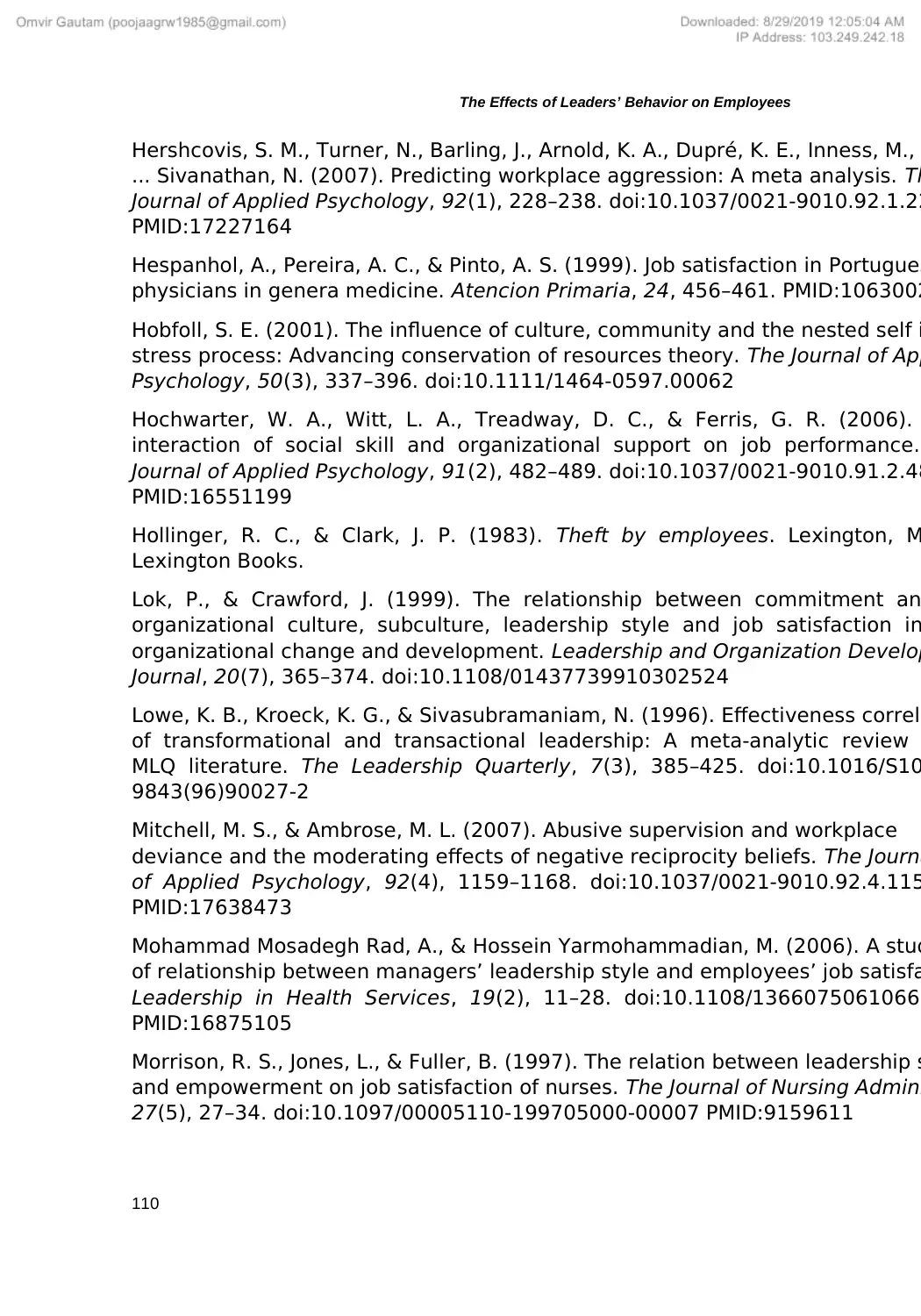
110
The Effects of Leaders’ Behavior on Employees
Hershcovis, S. M., Turner, N., Barling, J., Arnold, K. A., Dupré, K. E., Inness, M.,
... Sivanathan, N. (2007). Predicting workplace aggression: A meta analysis. Th
Journal of Applied Psychology, 92(1), 228–238. doi:10.1037/0021-9010.92.1.22
PMID:17227164
Hespanhol, A., Pereira, A. C., & Pinto, A. S. (1999). Job satisfaction in Portugues
physicians in genera medicine. Atencion Primaria, 24, 456–461. PMID:1063002
Hobfoll, S. E. (2001). The influence of culture, community and the nested self i
stress process: Advancing conservation of resources theory. The Journal of App
Psychology, 50(3), 337–396. doi:10.1111/1464-0597.00062
Hochwarter, W. A., Witt, L. A., Treadway, D. C., & Ferris, G. R. (2006).
interaction of social skill and organizational support on job performance.
Journal of Applied Psychology, 91(2), 482–489. doi:10.1037/0021-9010.91.2.48
PMID:16551199
Hollinger, R. C., & Clark, J. P. (1983). Theft by employees. Lexington, M
Lexington Books.
Lok, P., & Crawford, J. (1999). The relationship between commitment an
organizational culture, subculture, leadership style and job satisfaction in
organizational change and development. Leadership and Organization Develop
Journal, 20(7), 365–374. doi:10.1108/01437739910302524
Lowe, K. B., Kroeck, K. G., & Sivasubramaniam, N. (1996). Effectiveness correla
of transformational and transactional leadership: A meta-analytic review
MLQ literature. The Leadership Quarterly, 7(3), 385–425. doi:10.1016/S10
9843(96)90027-2
Mitchell, M. S., & Ambrose, M. L. (2007). Abusive supervision and workplace
deviance and the moderating effects of negative reciprocity beliefs. The Journa
of Applied Psychology, 92(4), 1159–1168. doi:10.1037/0021-9010.92.4.115
PMID:17638473
Mohammad Mosadegh Rad, A., & Hossein Yarmohammadian, M. (2006). A stud
of relationship between managers’ leadership style and employees’ job satisfa
Leadership in Health Services, 19(2), 11–28. doi:10.1108/13660750610665
PMID:16875105
Morrison, R. S., Jones, L., & Fuller, B. (1997). The relation between leadership s
and empowerment on job satisfaction of nurses. The Journal of Nursing Admini
27(5), 27–34. doi:10.1097/00005110-199705000-00007 PMID:9159611
The Effects of Leaders’ Behavior on Employees
Hershcovis, S. M., Turner, N., Barling, J., Arnold, K. A., Dupré, K. E., Inness, M.,
... Sivanathan, N. (2007). Predicting workplace aggression: A meta analysis. Th
Journal of Applied Psychology, 92(1), 228–238. doi:10.1037/0021-9010.92.1.22
PMID:17227164
Hespanhol, A., Pereira, A. C., & Pinto, A. S. (1999). Job satisfaction in Portugues
physicians in genera medicine. Atencion Primaria, 24, 456–461. PMID:1063002
Hobfoll, S. E. (2001). The influence of culture, community and the nested self i
stress process: Advancing conservation of resources theory. The Journal of App
Psychology, 50(3), 337–396. doi:10.1111/1464-0597.00062
Hochwarter, W. A., Witt, L. A., Treadway, D. C., & Ferris, G. R. (2006).
interaction of social skill and organizational support on job performance.
Journal of Applied Psychology, 91(2), 482–489. doi:10.1037/0021-9010.91.2.48
PMID:16551199
Hollinger, R. C., & Clark, J. P. (1983). Theft by employees. Lexington, M
Lexington Books.
Lok, P., & Crawford, J. (1999). The relationship between commitment an
organizational culture, subculture, leadership style and job satisfaction in
organizational change and development. Leadership and Organization Develop
Journal, 20(7), 365–374. doi:10.1108/01437739910302524
Lowe, K. B., Kroeck, K. G., & Sivasubramaniam, N. (1996). Effectiveness correla
of transformational and transactional leadership: A meta-analytic review
MLQ literature. The Leadership Quarterly, 7(3), 385–425. doi:10.1016/S10
9843(96)90027-2
Mitchell, M. S., & Ambrose, M. L. (2007). Abusive supervision and workplace
deviance and the moderating effects of negative reciprocity beliefs. The Journa
of Applied Psychology, 92(4), 1159–1168. doi:10.1037/0021-9010.92.4.115
PMID:17638473
Mohammad Mosadegh Rad, A., & Hossein Yarmohammadian, M. (2006). A stud
of relationship between managers’ leadership style and employees’ job satisfa
Leadership in Health Services, 19(2), 11–28. doi:10.1108/13660750610665
PMID:16875105
Morrison, R. S., Jones, L., & Fuller, B. (1997). The relation between leadership s
and empowerment on job satisfaction of nurses. The Journal of Nursing Admini
27(5), 27–34. doi:10.1097/00005110-199705000-00007 PMID:9159611
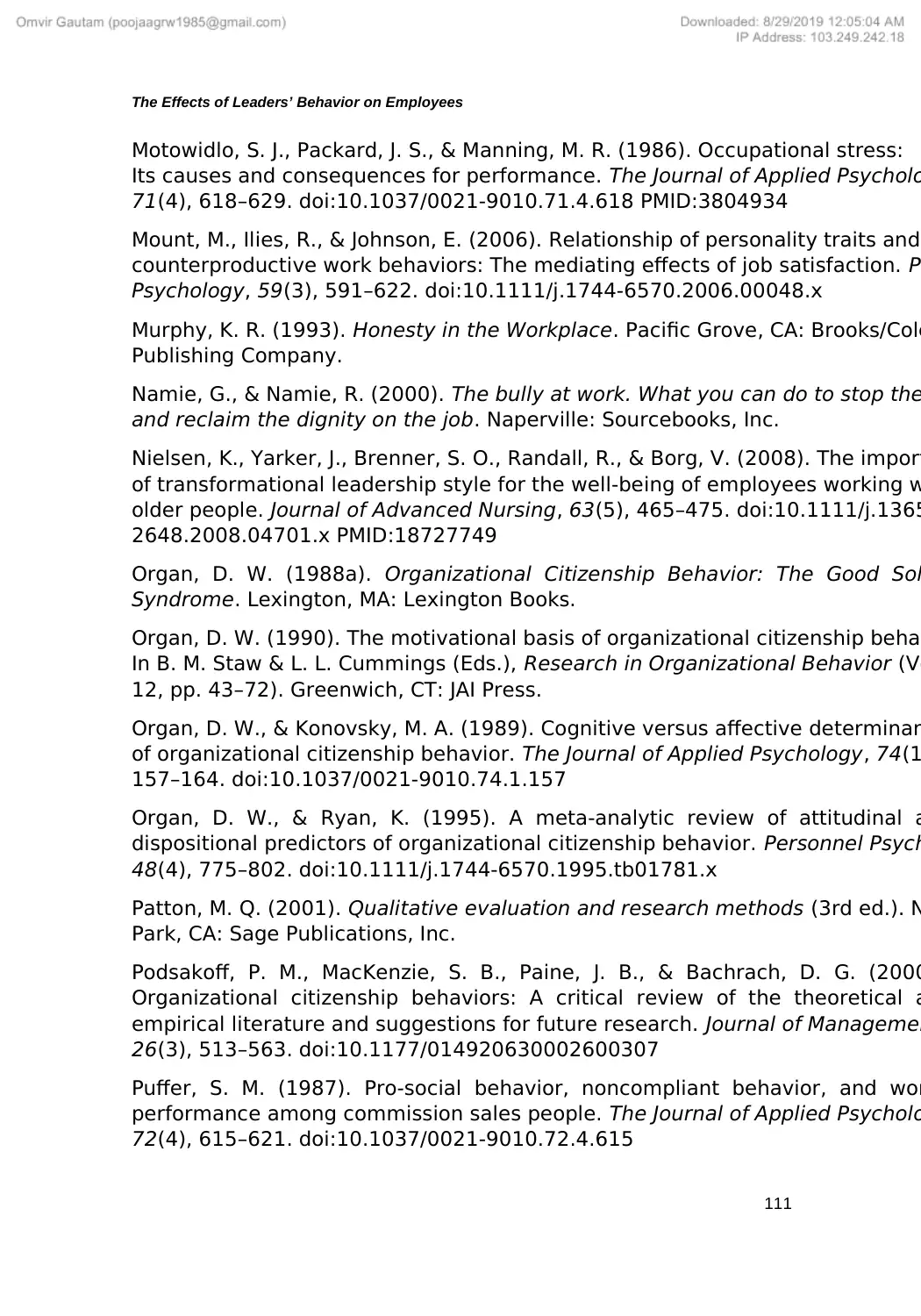
111
The Effects of Leaders’ Behavior on Employees
Motowidlo, S. J., Packard, J. S., & Manning, M. R. (1986). Occupational stress:
Its causes and consequences for performance. The Journal of Applied Psycholo
71(4), 618–629. doi:10.1037/0021-9010.71.4.618 PMID:3804934
Mount, M., Ilies, R., & Johnson, E. (2006). Relationship of personality traits and
counterproductive work behaviors: The mediating effects of job satisfaction. Pe
Psychology, 59(3), 591–622. doi:10.1111/j.1744-6570.2006.00048.x
Murphy, K. R. (1993). Honesty in the Workplace. Pacific Grove, CA: Brooks/Cole
Publishing Company.
Namie, G., & Namie, R. (2000). The bully at work. What you can do to stop the
and reclaim the dignity on the job. Naperville: Sourcebooks, Inc.
Nielsen, K., Yarker, J., Brenner, S. O., Randall, R., & Borg, V. (2008). The import
of transformational leadership style for the well‐being of employees working w
older people. Journal of Advanced Nursing, 63(5), 465–475. doi:10.1111/j.1365
2648.2008.04701.x PMID:18727749
Organ, D. W. (1988a). Organizational Citizenship Behavior: The Good Sol
Syndrome. Lexington, MA: Lexington Books.
Organ, D. W. (1990). The motivational basis of organizational citizenship behav
In B. M. Staw & L. L. Cummings (Eds.), Research in Organizational Behavior (Vo
12, pp. 43–72). Greenwich, CT: JAI Press.
Organ, D. W., & Konovsky, M. A. (1989). Cognitive versus affective determinan
of organizational citizenship behavior. The Journal of Applied Psychology, 74(1
157–164. doi:10.1037/0021-9010.74.1.157
Organ, D. W., & Ryan, K. (1995). A meta‐analytic review of attitudinal a
dispositional predictors of organizational citizenship behavior. Personnel Psych
48(4), 775–802. doi:10.1111/j.1744-6570.1995.tb01781.x
Patton, M. Q. (2001). Qualitative evaluation and research methods (3rd ed.). N
Park, CA: Sage Publications, Inc.
Podsakoff, P. M., MacKenzie, S. B., Paine, J. B., & Bachrach, D. G. (2000
Organizational citizenship behaviors: A critical review of the theoretical a
empirical literature and suggestions for future research. Journal of Managemen
26(3), 513–563. doi:10.1177/014920630002600307
Puffer, S. M. (1987). Pro-social behavior, noncompliant behavior, and wor
performance among commission sales people. The Journal of Applied Psycholo
72(4), 615–621. doi:10.1037/0021-9010.72.4.615
The Effects of Leaders’ Behavior on Employees
Motowidlo, S. J., Packard, J. S., & Manning, M. R. (1986). Occupational stress:
Its causes and consequences for performance. The Journal of Applied Psycholo
71(4), 618–629. doi:10.1037/0021-9010.71.4.618 PMID:3804934
Mount, M., Ilies, R., & Johnson, E. (2006). Relationship of personality traits and
counterproductive work behaviors: The mediating effects of job satisfaction. Pe
Psychology, 59(3), 591–622. doi:10.1111/j.1744-6570.2006.00048.x
Murphy, K. R. (1993). Honesty in the Workplace. Pacific Grove, CA: Brooks/Cole
Publishing Company.
Namie, G., & Namie, R. (2000). The bully at work. What you can do to stop the
and reclaim the dignity on the job. Naperville: Sourcebooks, Inc.
Nielsen, K., Yarker, J., Brenner, S. O., Randall, R., & Borg, V. (2008). The import
of transformational leadership style for the well‐being of employees working w
older people. Journal of Advanced Nursing, 63(5), 465–475. doi:10.1111/j.1365
2648.2008.04701.x PMID:18727749
Organ, D. W. (1988a). Organizational Citizenship Behavior: The Good Sol
Syndrome. Lexington, MA: Lexington Books.
Organ, D. W. (1990). The motivational basis of organizational citizenship behav
In B. M. Staw & L. L. Cummings (Eds.), Research in Organizational Behavior (Vo
12, pp. 43–72). Greenwich, CT: JAI Press.
Organ, D. W., & Konovsky, M. A. (1989). Cognitive versus affective determinan
of organizational citizenship behavior. The Journal of Applied Psychology, 74(1
157–164. doi:10.1037/0021-9010.74.1.157
Organ, D. W., & Ryan, K. (1995). A meta‐analytic review of attitudinal a
dispositional predictors of organizational citizenship behavior. Personnel Psych
48(4), 775–802. doi:10.1111/j.1744-6570.1995.tb01781.x
Patton, M. Q. (2001). Qualitative evaluation and research methods (3rd ed.). N
Park, CA: Sage Publications, Inc.
Podsakoff, P. M., MacKenzie, S. B., Paine, J. B., & Bachrach, D. G. (2000
Organizational citizenship behaviors: A critical review of the theoretical a
empirical literature and suggestions for future research. Journal of Managemen
26(3), 513–563. doi:10.1177/014920630002600307
Puffer, S. M. (1987). Pro-social behavior, noncompliant behavior, and wor
performance among commission sales people. The Journal of Applied Psycholo
72(4), 615–621. doi:10.1037/0021-9010.72.4.615
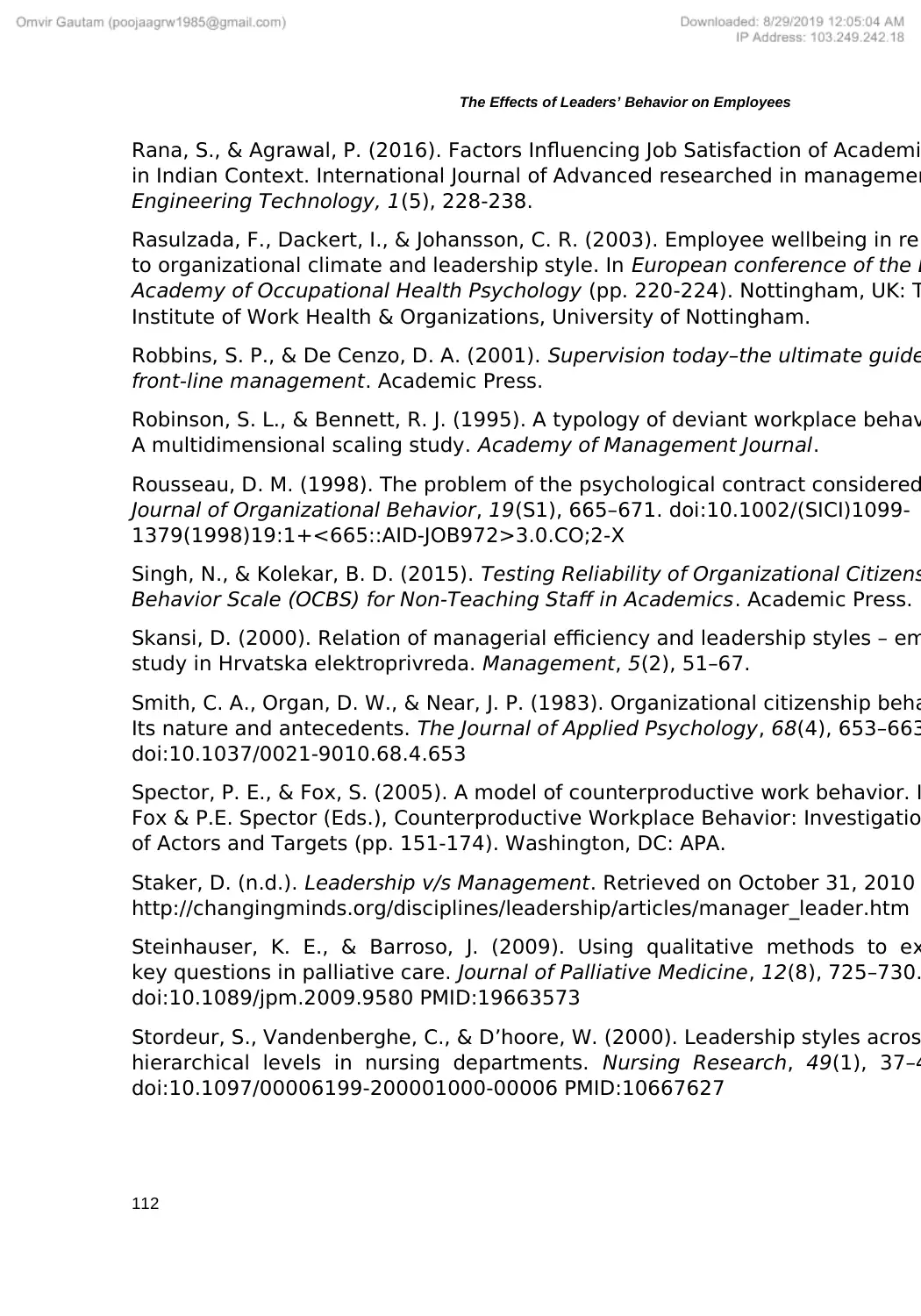
112
The Effects of Leaders’ Behavior on Employees
Rana, S., & Agrawal, P. (2016). Factors Influencing Job Satisfaction of Academi
in Indian Context. International Journal of Advanced researched in managemen
Engineering Technology, 1(5), 228-238.
Rasulzada, F., Dackert, I., & Johansson, C. R. (2003). Employee wellbeing in rel
to organizational climate and leadership style. In European conference of the E
Academy of Occupational Health Psychology (pp. 220-224). Nottingham, UK: T
Institute of Work Health & Organizations, University of Nottingham.
Robbins, S. P., & De Cenzo, D. A. (2001). Supervision today–the ultimate guide
front-line management. Academic Press.
Robinson, S. L., & Bennett, R. J. (1995). A typology of deviant workplace behav
A multidimensional scaling study. Academy of Management Journal.
Rousseau, D. M. (1998). The problem of the psychological contract considered
Journal of Organizational Behavior, 19(S1), 665–671. doi:10.1002/(SICI)1099-
1379(1998)19:1+<665::AID-JOB972>3.0.CO;2-X
Singh, N., & Kolekar, B. D. (2015). Testing Reliability of Organizational Citizens
Behavior Scale (OCBS) for Non-Teaching Staff in Academics. Academic Press.
Skansi, D. (2000). Relation of managerial efficiency and leadership styles – em
study in Hrvatska elektroprivreda. Management, 5(2), 51–67.
Smith, C. A., Organ, D. W., & Near, J. P. (1983). Organizational citizenship beha
Its nature and antecedents. The Journal of Applied Psychology, 68(4), 653–663
doi:10.1037/0021-9010.68.4.653
Spector, P. E., & Fox, S. (2005). A model of counterproductive work behavior. I
Fox & P.E. Spector (Eds.), Counterproductive Workplace Behavior: Investigatio
of Actors and Targets (pp. 151-174). Washington, DC: APA.
Staker, D. (n.d.). Leadership v/s Management. Retrieved on October 31, 2010
http://changingminds.org/disciplines/leadership/articles/manager_leader.htm
Steinhauser, K. E., & Barroso, J. (2009). Using qualitative methods to ex
key questions in palliative care. Journal of Palliative Medicine, 12(8), 725–730.
doi:10.1089/jpm.2009.9580 PMID:19663573
Stordeur, S., Vandenberghe, C., & D’hoore, W. (2000). Leadership styles acros
hierarchical levels in nursing departments. Nursing Research, 49(1), 37–4
doi:10.1097/00006199-200001000-00006 PMID:10667627
The Effects of Leaders’ Behavior on Employees
Rana, S., & Agrawal, P. (2016). Factors Influencing Job Satisfaction of Academi
in Indian Context. International Journal of Advanced researched in managemen
Engineering Technology, 1(5), 228-238.
Rasulzada, F., Dackert, I., & Johansson, C. R. (2003). Employee wellbeing in rel
to organizational climate and leadership style. In European conference of the E
Academy of Occupational Health Psychology (pp. 220-224). Nottingham, UK: T
Institute of Work Health & Organizations, University of Nottingham.
Robbins, S. P., & De Cenzo, D. A. (2001). Supervision today–the ultimate guide
front-line management. Academic Press.
Robinson, S. L., & Bennett, R. J. (1995). A typology of deviant workplace behav
A multidimensional scaling study. Academy of Management Journal.
Rousseau, D. M. (1998). The problem of the psychological contract considered
Journal of Organizational Behavior, 19(S1), 665–671. doi:10.1002/(SICI)1099-
1379(1998)19:1+<665::AID-JOB972>3.0.CO;2-X
Singh, N., & Kolekar, B. D. (2015). Testing Reliability of Organizational Citizens
Behavior Scale (OCBS) for Non-Teaching Staff in Academics. Academic Press.
Skansi, D. (2000). Relation of managerial efficiency and leadership styles – em
study in Hrvatska elektroprivreda. Management, 5(2), 51–67.
Smith, C. A., Organ, D. W., & Near, J. P. (1983). Organizational citizenship beha
Its nature and antecedents. The Journal of Applied Psychology, 68(4), 653–663
doi:10.1037/0021-9010.68.4.653
Spector, P. E., & Fox, S. (2005). A model of counterproductive work behavior. I
Fox & P.E. Spector (Eds.), Counterproductive Workplace Behavior: Investigatio
of Actors and Targets (pp. 151-174). Washington, DC: APA.
Staker, D. (n.d.). Leadership v/s Management. Retrieved on October 31, 2010
http://changingminds.org/disciplines/leadership/articles/manager_leader.htm
Steinhauser, K. E., & Barroso, J. (2009). Using qualitative methods to ex
key questions in palliative care. Journal of Palliative Medicine, 12(8), 725–730.
doi:10.1089/jpm.2009.9580 PMID:19663573
Stordeur, S., Vandenberghe, C., & D’hoore, W. (2000). Leadership styles acros
hierarchical levels in nursing departments. Nursing Research, 49(1), 37–4
doi:10.1097/00006199-200001000-00006 PMID:10667627
Paraphrase This Document
Need a fresh take? Get an instant paraphrase of this document with our AI Paraphraser
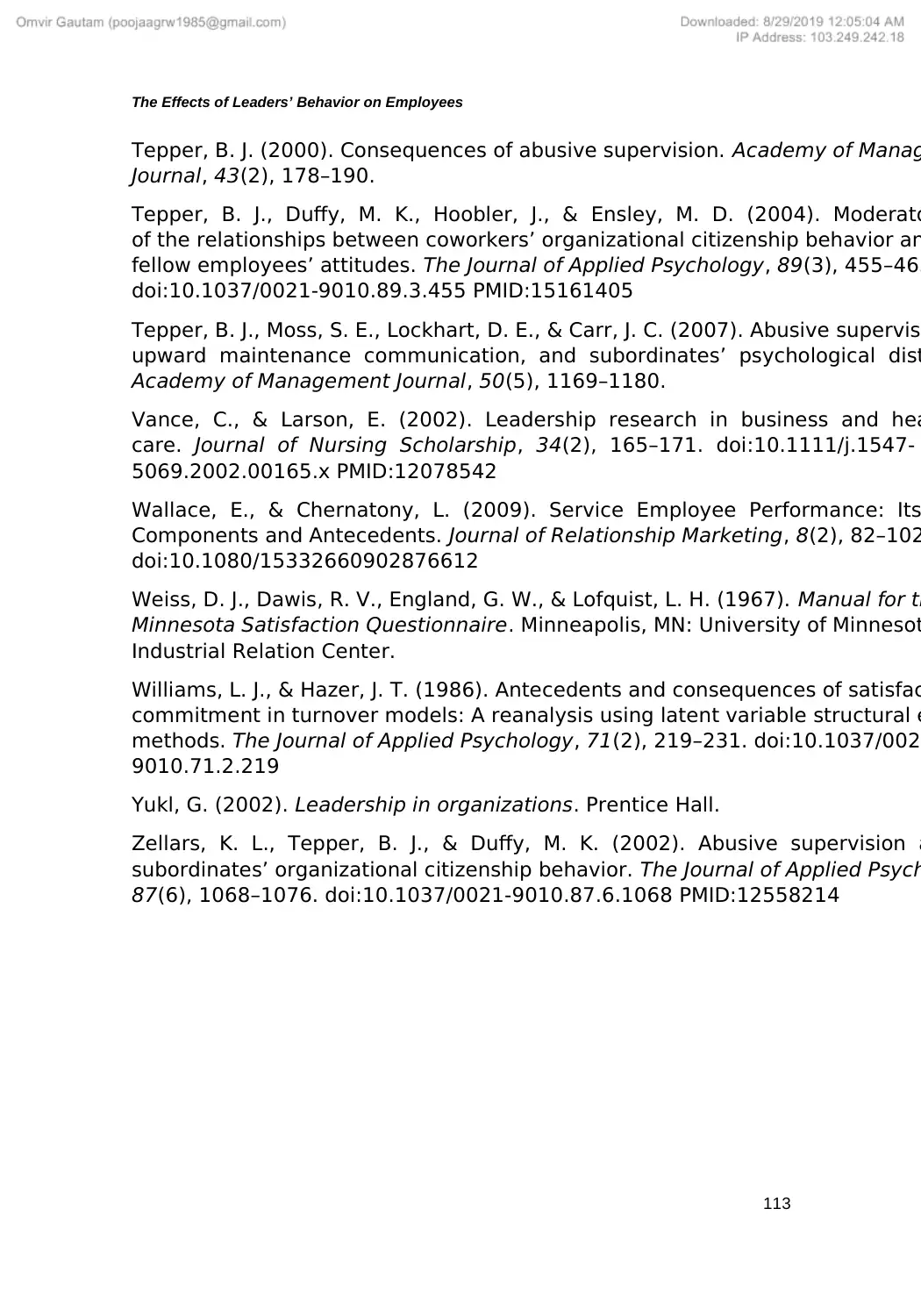
113
The Effects of Leaders’ Behavior on Employees
Tepper, B. J. (2000). Consequences of abusive supervision. Academy of Manag
Journal, 43(2), 178–190.
Tepper, B. J., Duffy, M. K., Hoobler, J., & Ensley, M. D. (2004). Moderato
of the relationships between coworkers’ organizational citizenship behavior an
fellow employees’ attitudes. The Journal of Applied Psychology, 89(3), 455–465
doi:10.1037/0021-9010.89.3.455 PMID:15161405
Tepper, B. J., Moss, S. E., Lockhart, D. E., & Carr, J. C. (2007). Abusive supervisi
upward maintenance communication, and subordinates’ psychological dist
Academy of Management Journal, 50(5), 1169–1180.
Vance, C., & Larson, E. (2002). Leadership research in business and hea
care. Journal of Nursing Scholarship, 34(2), 165–171. doi:10.1111/j.1547-
5069.2002.00165.x PMID:12078542
Wallace, E., & Chernatony, L. (2009). Service Employee Performance: Its
Components and Antecedents. Journal of Relationship Marketing, 8(2), 82–102
doi:10.1080/15332660902876612
Weiss, D. J., Dawis, R. V., England, G. W., & Lofquist, L. H. (1967). Manual for th
Minnesota Satisfaction Questionnaire. Minneapolis, MN: University of Minnesot
Industrial Relation Center.
Williams, L. J., & Hazer, J. T. (1986). Antecedents and consequences of satisfac
commitment in turnover models: A reanalysis using latent variable structural e
methods. The Journal of Applied Psychology, 71(2), 219–231. doi:10.1037/0021
9010.71.2.219
Yukl, G. (2002). Leadership in organizations. Prentice Hall.
Zellars, K. L., Tepper, B. J., & Duffy, M. K. (2002). Abusive supervision a
subordinates’ organizational citizenship behavior. The Journal of Applied Psych
87(6), 1068–1076. doi:10.1037/0021-9010.87.6.1068 PMID:12558214
The Effects of Leaders’ Behavior on Employees
Tepper, B. J. (2000). Consequences of abusive supervision. Academy of Manag
Journal, 43(2), 178–190.
Tepper, B. J., Duffy, M. K., Hoobler, J., & Ensley, M. D. (2004). Moderato
of the relationships between coworkers’ organizational citizenship behavior an
fellow employees’ attitudes. The Journal of Applied Psychology, 89(3), 455–465
doi:10.1037/0021-9010.89.3.455 PMID:15161405
Tepper, B. J., Moss, S. E., Lockhart, D. E., & Carr, J. C. (2007). Abusive supervisi
upward maintenance communication, and subordinates’ psychological dist
Academy of Management Journal, 50(5), 1169–1180.
Vance, C., & Larson, E. (2002). Leadership research in business and hea
care. Journal of Nursing Scholarship, 34(2), 165–171. doi:10.1111/j.1547-
5069.2002.00165.x PMID:12078542
Wallace, E., & Chernatony, L. (2009). Service Employee Performance: Its
Components and Antecedents. Journal of Relationship Marketing, 8(2), 82–102
doi:10.1080/15332660902876612
Weiss, D. J., Dawis, R. V., England, G. W., & Lofquist, L. H. (1967). Manual for th
Minnesota Satisfaction Questionnaire. Minneapolis, MN: University of Minnesot
Industrial Relation Center.
Williams, L. J., & Hazer, J. T. (1986). Antecedents and consequences of satisfac
commitment in turnover models: A reanalysis using latent variable structural e
methods. The Journal of Applied Psychology, 71(2), 219–231. doi:10.1037/0021
9010.71.2.219
Yukl, G. (2002). Leadership in organizations. Prentice Hall.
Zellars, K. L., Tepper, B. J., & Duffy, M. K. (2002). Abusive supervision a
subordinates’ organizational citizenship behavior. The Journal of Applied Psych
87(6), 1068–1076. doi:10.1037/0021-9010.87.6.1068 PMID:12558214
1 out of 14
Your All-in-One AI-Powered Toolkit for Academic Success.
+13062052269
info@desklib.com
Available 24*7 on WhatsApp / Email
![[object Object]](/_next/static/media/star-bottom.7253800d.svg)
Unlock your academic potential
© 2024 | Zucol Services PVT LTD | All rights reserved.

